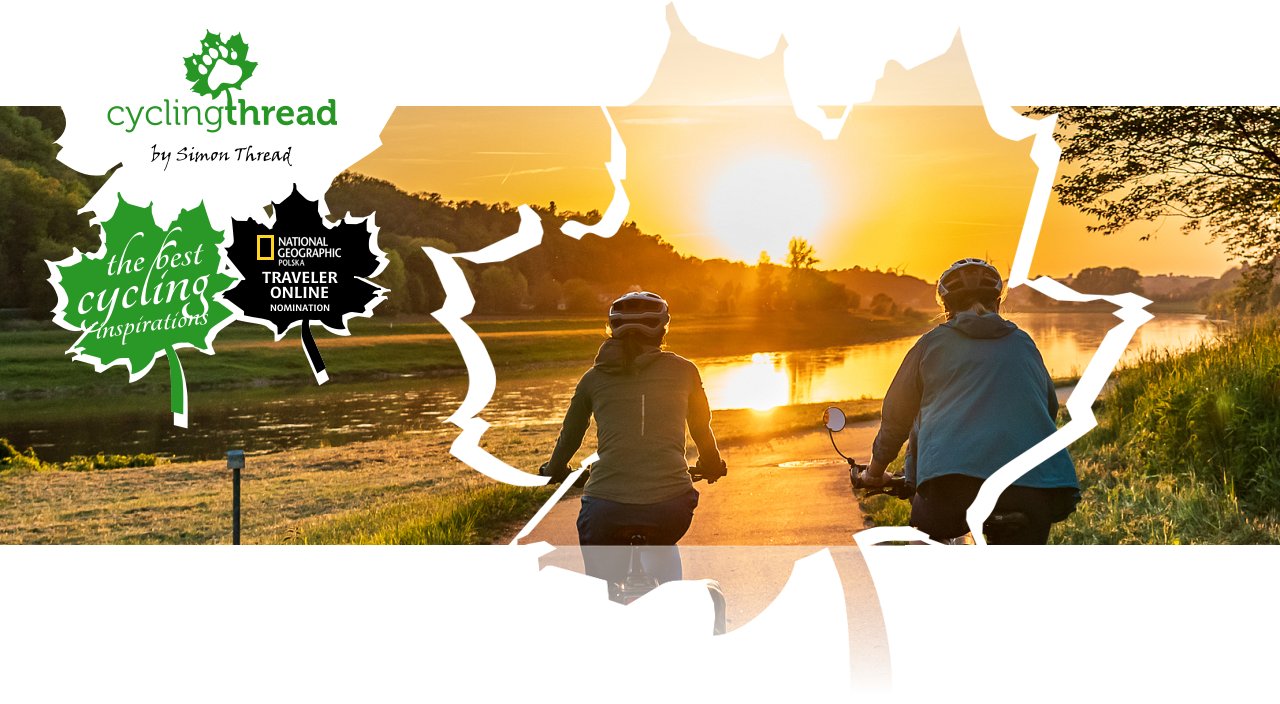
Cycling Elberadweg. The Elbe Cycle Route from Dresden to Magdeburg
Elberadweg, the Elbe Cycle Route, is Germany's favorite cycling route and one of the most popular in the country. This year it celebrates its 30th anniversary - a perfect reason to see how the queen of German cycling routes is doing, and how three decades of existence have shaped its comfort and organization. Over a long weekend in May, we rode one of the most frequently chosen sections - testing out various surfaces, staying at cyclist-friendly accommodations, and enjoying near-summer temperatures already at the start of the month. We began in beautiful Dresden and followed the route through Meissen, Torgau, Wittenberg and Dessau-Roßlau, ending in Magdeburg.
Route on the map
GPX file (GPS track): cyclingthread.com-elbe-2025.gpx
The Elbe Cycle Route - table of contents
- Elbe - one of the most popular in Europe
- A fantastic free roadbook for cyclists
- Perfect for cycling holidays or weekend trips
- Easy access with German trains
- A dream city to begin your cycling trip
- Number one - the Historic Green Vault
- The recently rebuilt Frauenkirche
- Military history, cars, culture, and transport
- First kilometers along the Elbe Route
- Scenic setting at Wackerbarth Palace
- A full mosaic of surfaces under our wheels
- Caspar David Friedrich painted the Elbe too
- Walpurgis Night at the castle in Meissen
- A perfect ending to the day by the Elbe
- The best overnight stay on the Elbe Cycle Route
- Schloss Seußlitz just a few steps off the route
- A route with a wonderfully gentle character
- Cycle paths on both sides of the river
- Steel industry and a historic encounter
- Germany's first cycling church
- Cycling through the Middle Elbe Biosphere Reserve
- Centuries of history in quiet Torgau
- Oxbow lakes and floodplain forests along the Elbe
- They don’t want walls - they want riverside identity
- Wittenberg - second best after Dresden
- Cyclist‑friendly hotels along Elberadweg
- The absolutely enchanting Dessau-Wörlitz Gardens
- Bauhaus: revolutionary design in Dessau-Roßlau
- Three UNESCO World Heritage Sites in one day
- Dessau-Roßlau demolishes housing blocks
- The red kite - a guardian of the Elbe
- Concrete barriers protect the forest
- Small castles and palaces along the route
- An extraordinary flood protection structure
- Magdeburg left us expecting more
- The Green Citadel, in stark contrast to the cathedral
- Exemplary German cycle wayfinding
- The Elbe Cycle Route leaves you richer
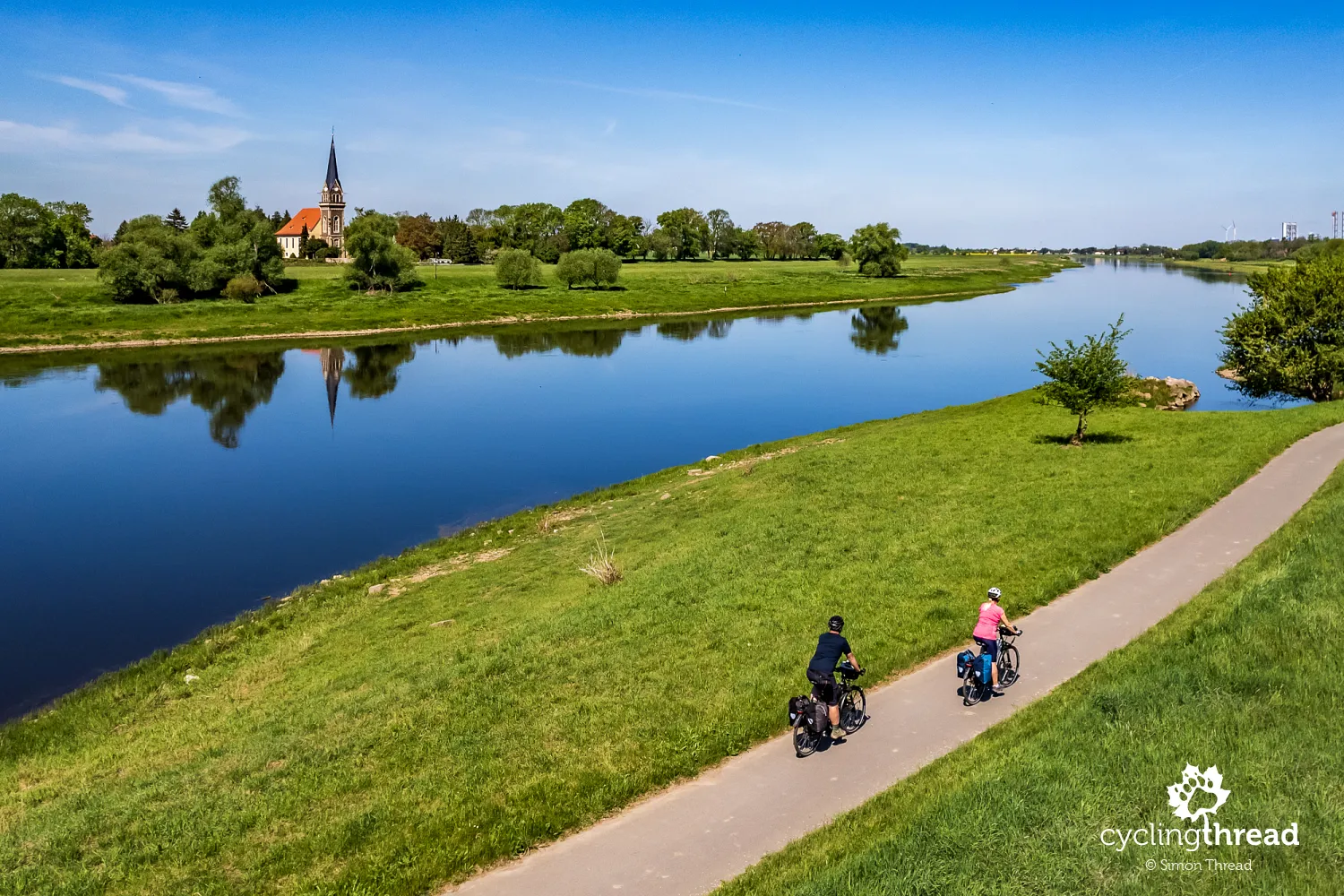
Elbe - one of the most popular in Europe
Elberadweg is also one of the most popular cycle routes in all of Europe. It stretches for around 1200 kilometers along the Elbe River - from its source in the Czech Krkonoše Mountains all the way to its mouth in the German town of Cuxhaven, on the North Sea. In general, the Elbe Route offers a varied landscape - from mountain valleys in the Czech Republic and southern Germany, through picturesque vineyards, to vast lowlands and the coastal north. As is often the case in Germany, the route is well signposted and easy to navigate. Like all great river routes, Elberadweg is mostly flat and suitable for cyclists of all skill levels, although... more on that later in the article. The Elbe Cycle Route is also known for its excellent tourism infrastructure - not only does it feature Bett+Bike, Germany's national network of cyclist-friendly accommodations, but also a smaller network dedicated exclusively to hosts located directly along the Elbe.
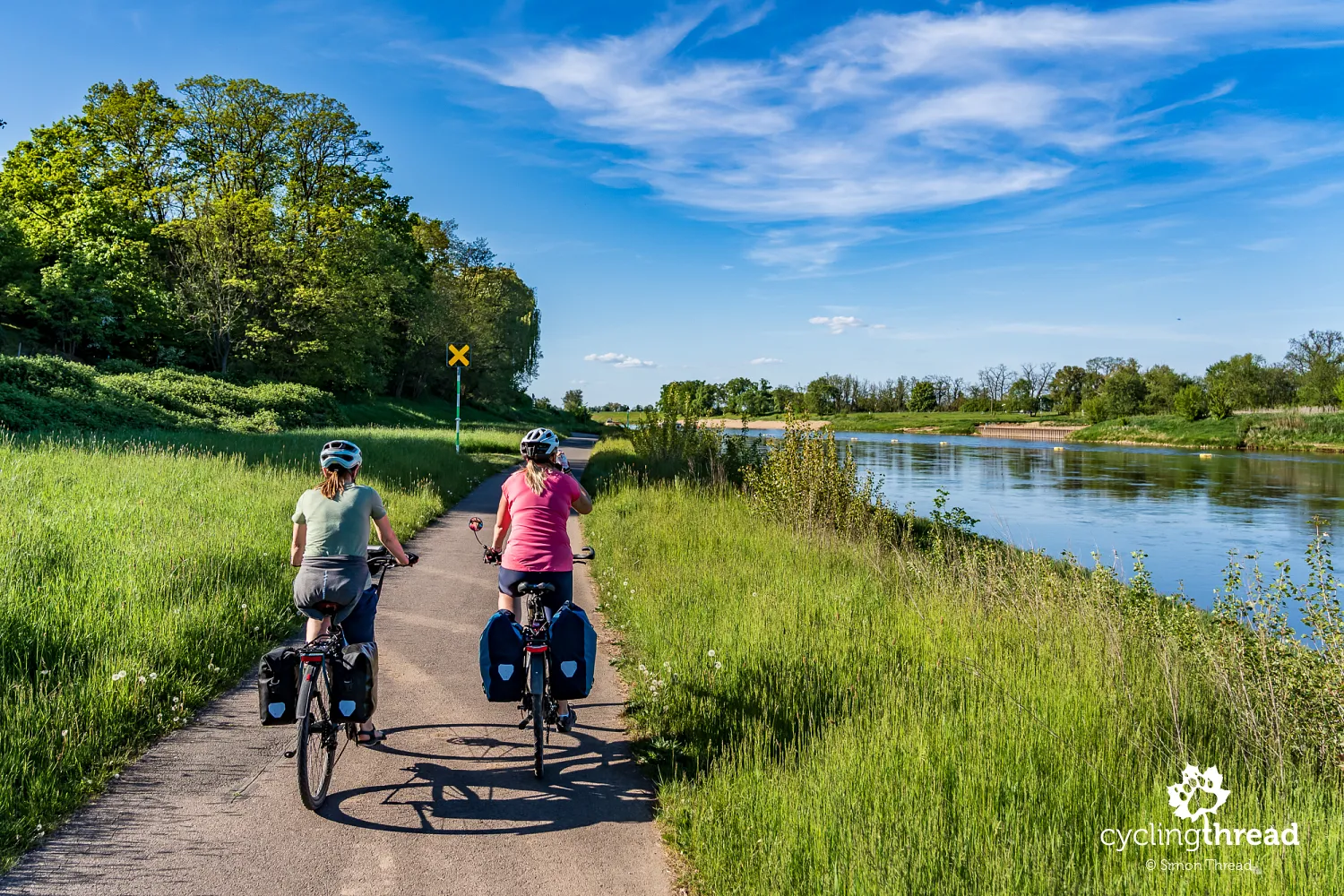
A fantastic free roadbook for cyclists
A list of cyclist-friendly places can be found not only on the official website www.elberadweg.de, but also in a very well-designed, free Elberadweg guidebook that serves as a cycling atlas. This handy little book, perfectly sized for a handlebar map holder, includes over 100 pages of route information - from general tips to detailed maps. And it's the maps that truly shine: they show not only the exact route on both banks of the Elbe, but also clearly marked distances, links to other cycling routes, locations of accommodations, restaurants, and attractions. The guide also contains a QR code leading to a webpage with current updates about construction work and detours. It's a really valuable tool for any journey. And it’s free!
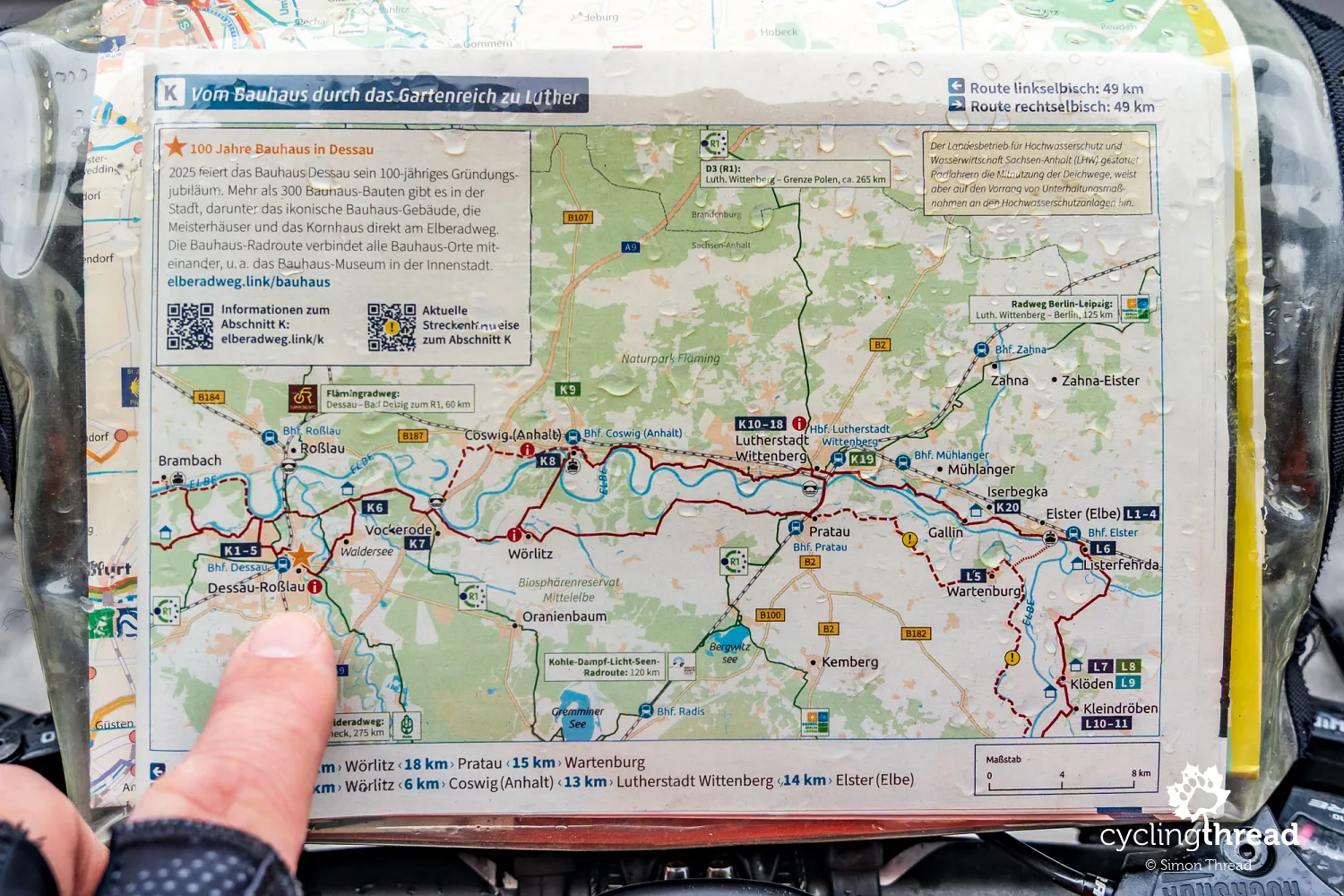
Perfect for cycling holidays or weekend trips
The Elbe Cycle Route can inspire a long-distance cycling journey, but thanks to convenient rail and road connections, it's also perfect for shorter cycling holidays in Germany or even weekend trips. In fact, the cities along the Elbe naturally suggest practical and interesting route options. The first section, starting from the source, runs from Prague (initially following the Vltava) to Dresden (about 240 km) - mostly on the Czech side, passing through the scenic Elbe canyon and the famous Saxon Switzerland. The next stage - from Dresden to Magdeburg (about 300 km) - is the one described in this article. Then comes a more weekend-friendly idea: from Magdeburg to Wittenberge (not to be confused with Luther’s Wittenberg) in northern Brandenburg (about 150 km), well connected with Berlin at both ends. And finally, there’s the stage from Wittenberge to Hamburg (about 190 km) - with the option of extending the ride to the North Sea and connecting with EuroVelo 12, the North Sea Route.
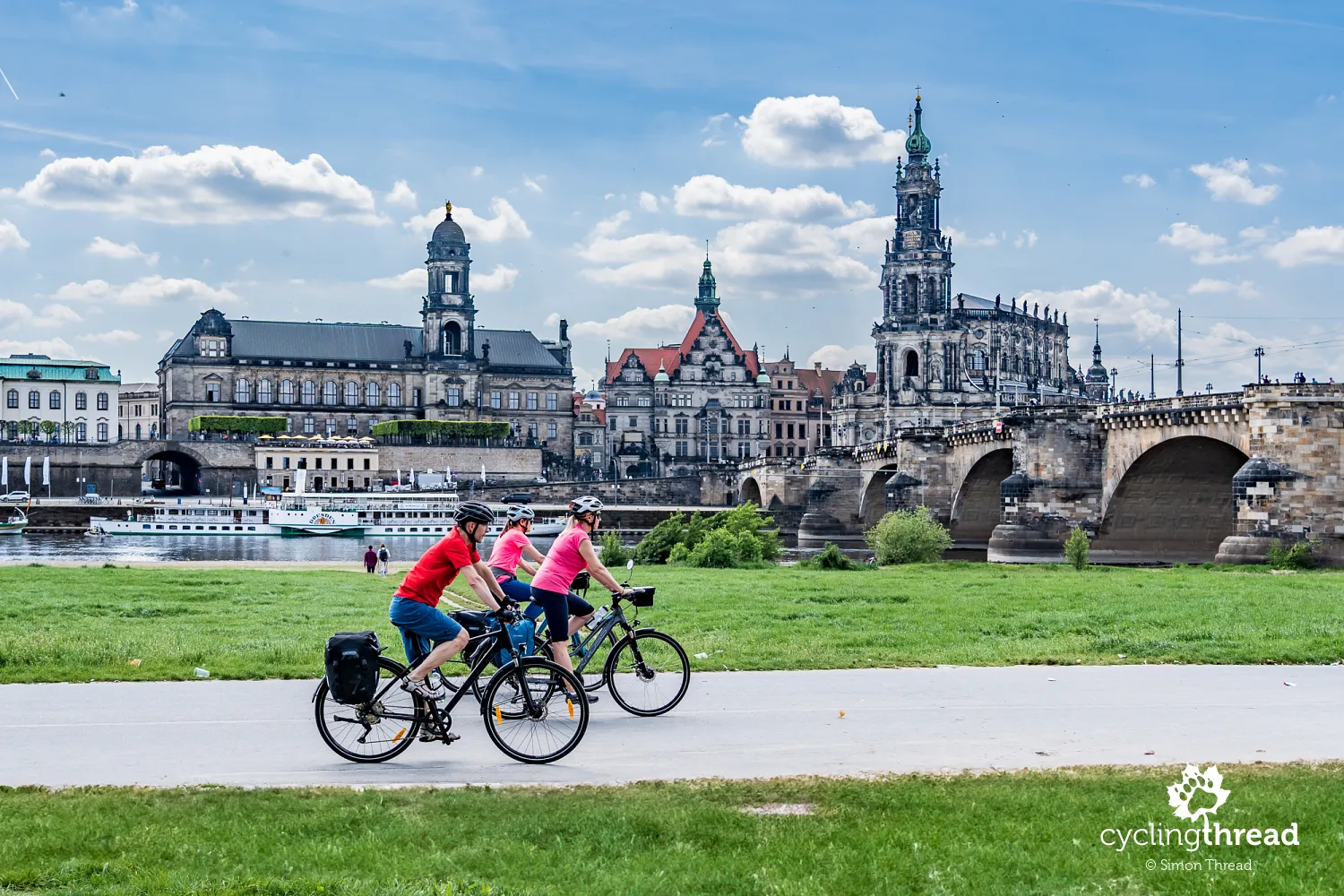
Easy access with German trains
You can start your Elberadweg adventure by arriving in southern Germany either by train or by car. If you choose the train, bringing your bike along is no problem - all regional trains accept bicycles, and no reservation is needed. Driving by car to Dresden (or Magdeburg) is just as easy, and getting back to your starting point - where you left your car - will be simple thanks to a fast InterCity train operated by Deutsche Bahn. This long-distance double-decker train connects Dresden and Magdeburg in under three hours and features a spacious, comfortable bike compartment for up to six bicycles. Just keep in mind: this train does require seat and bike reservations.
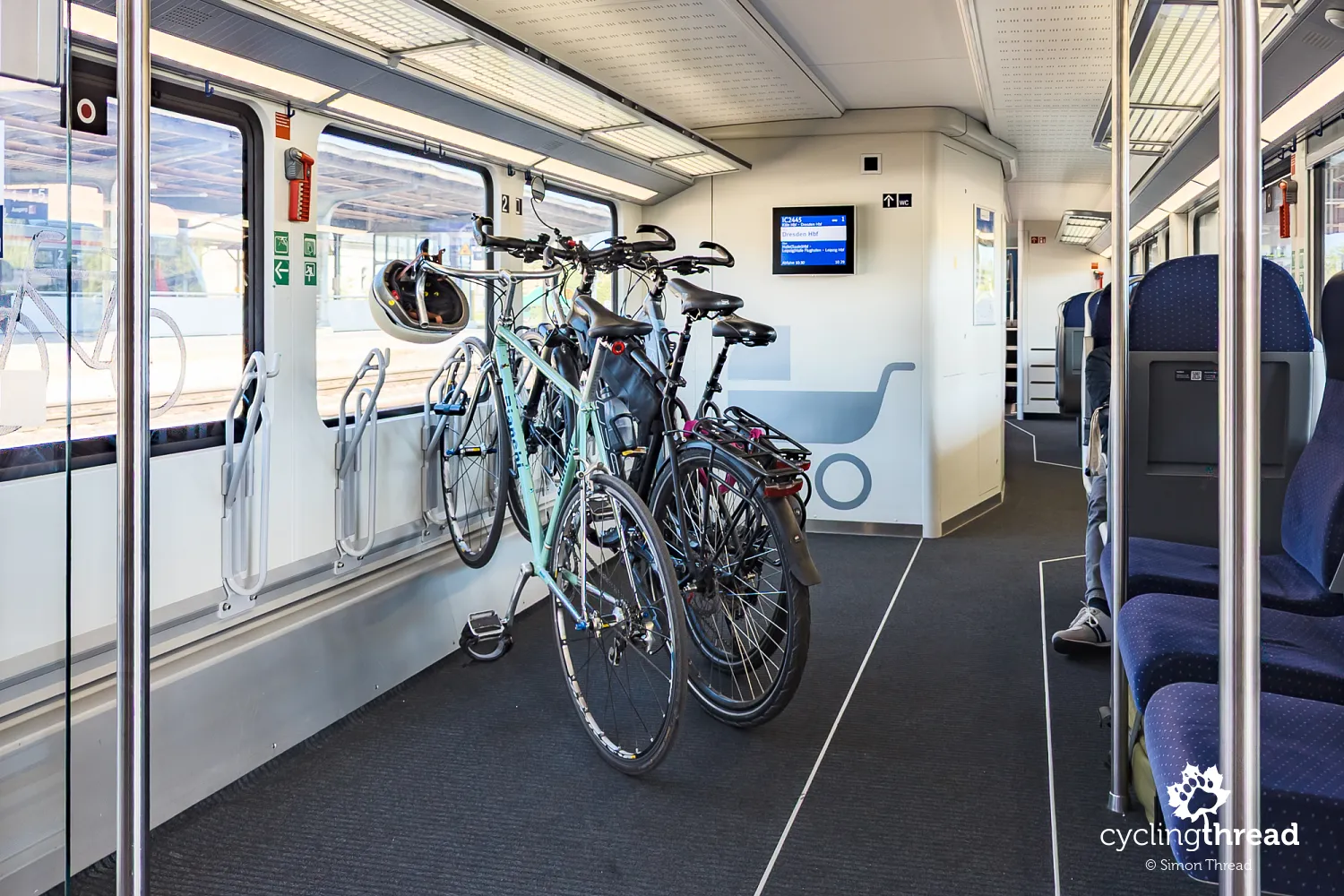
A dream city to begin your cycling trip
Dresden is one of those dream spots to start a cycling trip. Perhaps even one of the most exciting - full of variety and offering attractions of real cultural value. If you have a bit more time and you're not focused solely on riding the Elbe Route, Dresden is well worth spending 2-3 days before setting off. And even though the city has over half a million residents, most of its must-see attractions are packed into a relatively small area - including the rebuilt Old Town.
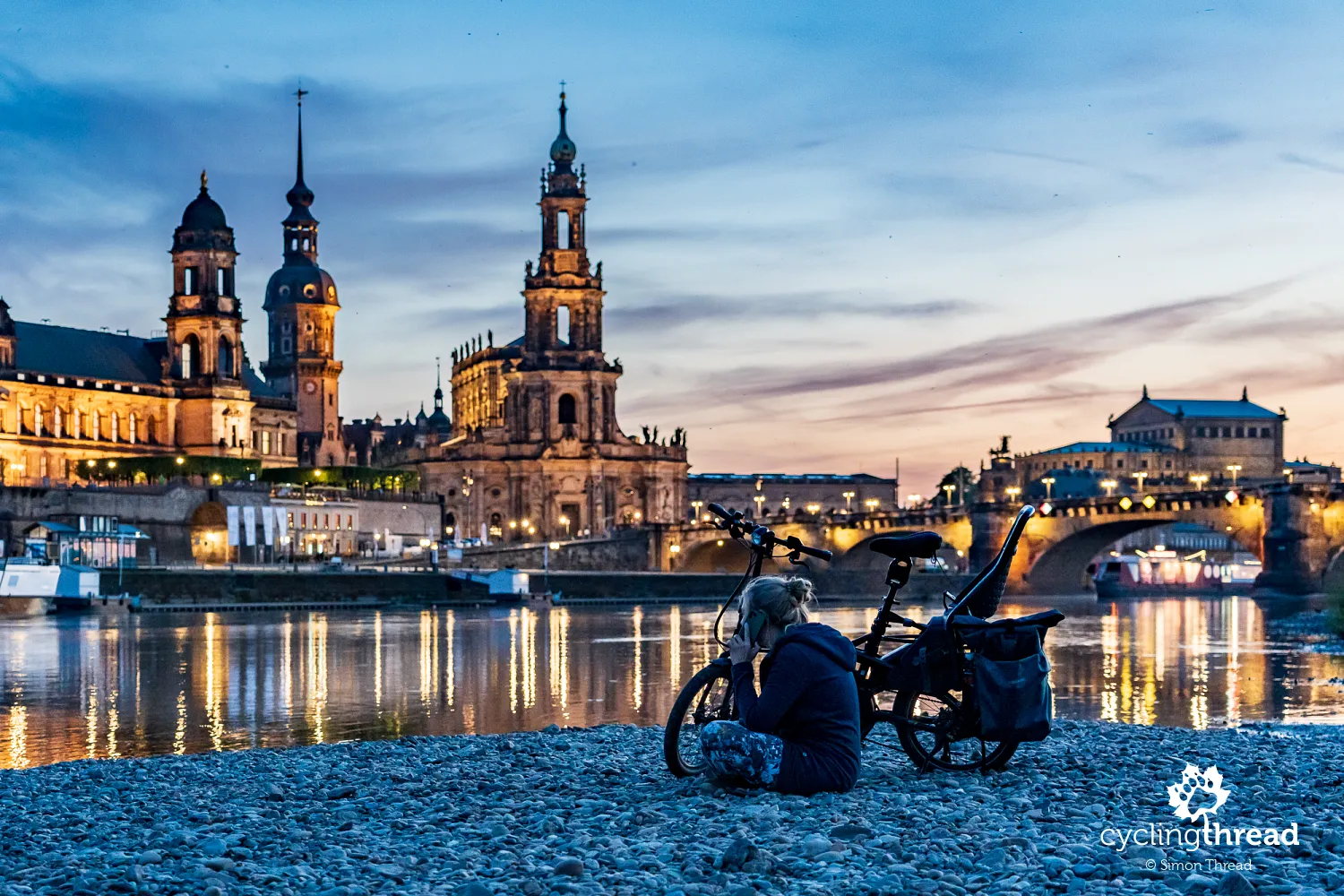
Number one - the Historic Green Vault
The number one site in Dresden is the Historic Green Vault in the Royal Palace - one of Europe’s oldest and richest collections of jewels and decorative art. It houses priceless masterpieces of jewelry, royal regalia, and exquisitely crafted items made from gold, silver, ivory, and amber. Among the treasures are emerald- and ruby-studded vessels once reserved for the most powerful monarchs. The exhibition has been restored according to the 18th-century vision of Augustus the Strong, Elector of Saxony, who created a baroque-style "cabinet of wonders". The collection dazzles not just with its contents, but also with its setting - visitors move through lavishly decorated halls where every piece gleams under carefully arranged lighting. It’s a good idea to book tickets in advance - daily visitor numbers are limited.
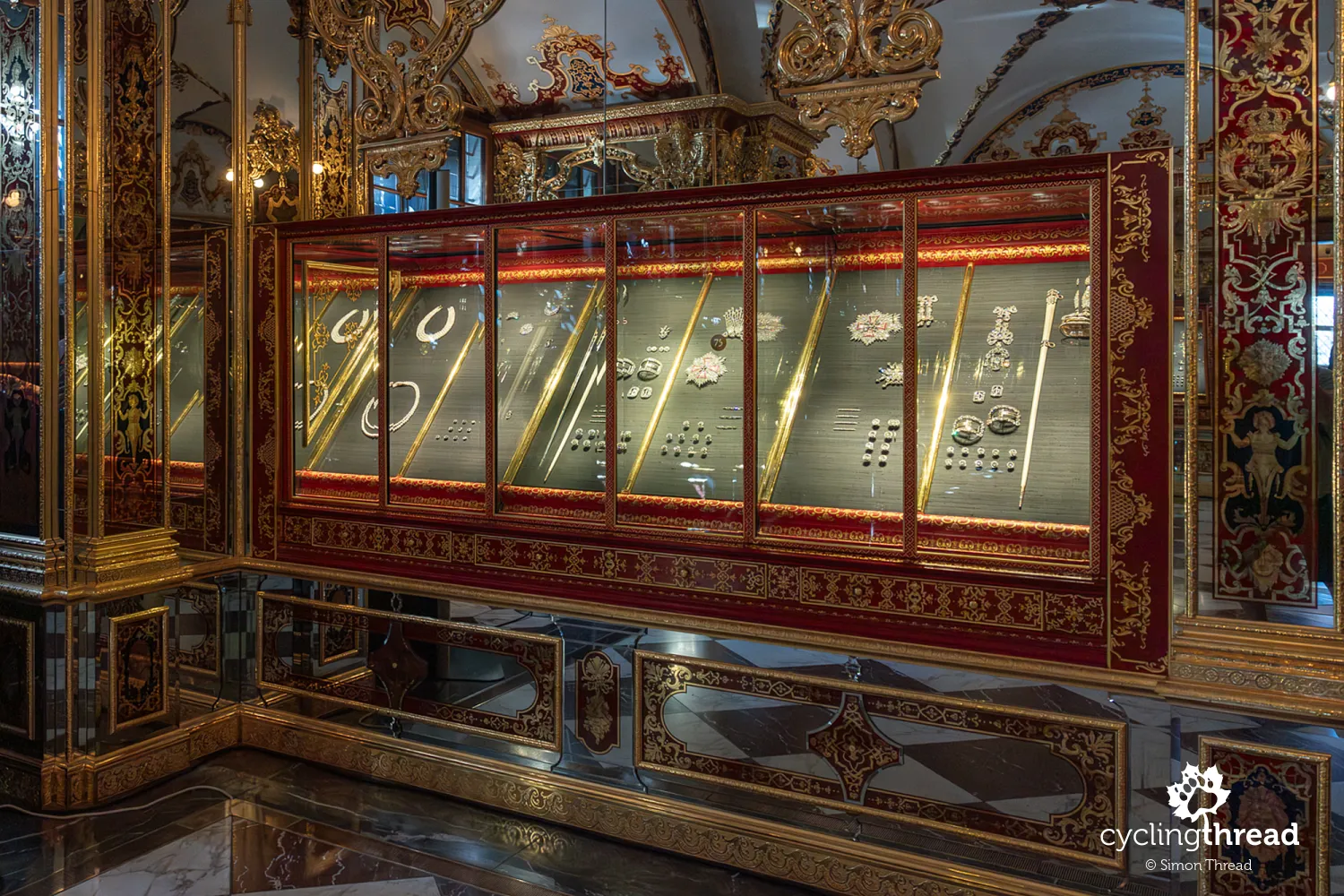
The recently rebuilt Frauenkirche
Dresden’s Old Town is a gem of baroque architecture - though much of what we see today is the result of painstaking reconstruction after World War II. The symbol of this process is the Protestant Church of Our Lady, or Frauenkirche - a monumental church with a striking stone dome that dominated the city skyline for centuries. Built between 1726 and 1743 based on a design by George Bähr, Frauenkirche was considered a masterpiece of Protestant architecture and one of the largest domed stone structures in Europe. On the night of February 13-14, 1945, the church was completely destroyed during an Allied air raid, and its ruins stood as a war memorial for decades. Only after German reunification did a large-scale reconstruction begin, completed in 2005.
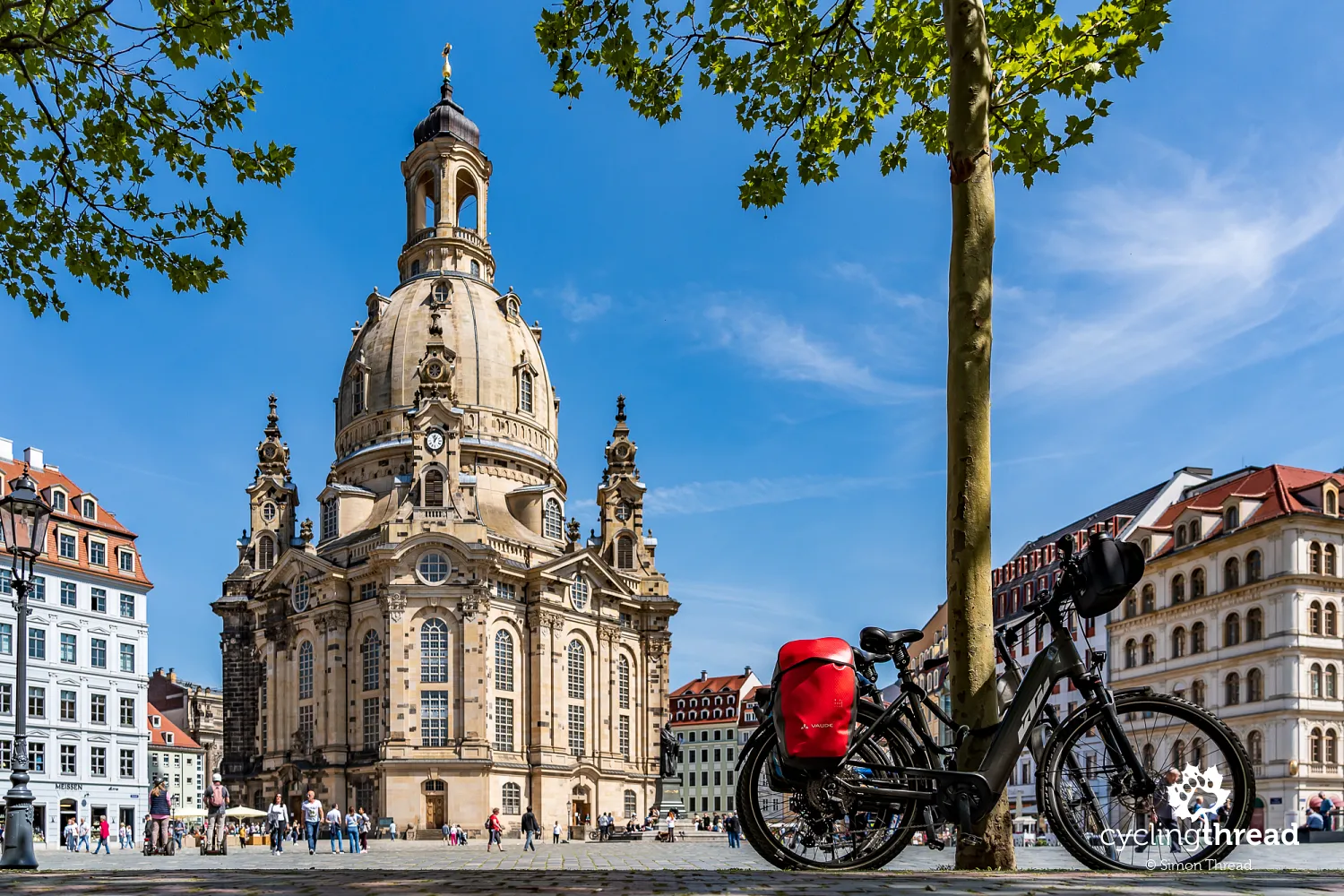
Dresden is also famous for its spectacular Old Town skyline, best viewed in the evening from the opposite bank of the Elbe. Depending on the season, the sun lights up the city’s landmarks at different heights and angles, creating a new mix of colors and moods every day. The skyline is marked by the towering dome of the Frauenkirche and the slender spire of the Catholic Hofkirche cathedral. Nearby stand the neoclassical Albertinum, the recognizable silhouette of the Semper Opera House, and the baroque Zwinger palace complex. This harmonious line of grand buildings, reflected in the calm waters of the Elbe at dusk, is what earned Dresden its nickname - the Florence on the Elbe. The city’s picturesque view was immortalized in the 18th century by Bernardo Bellotto, known as Canaletto - court painter to Augustus III - whose detailed cityscapes remain a valuable record of Dresden’s historic architecture.
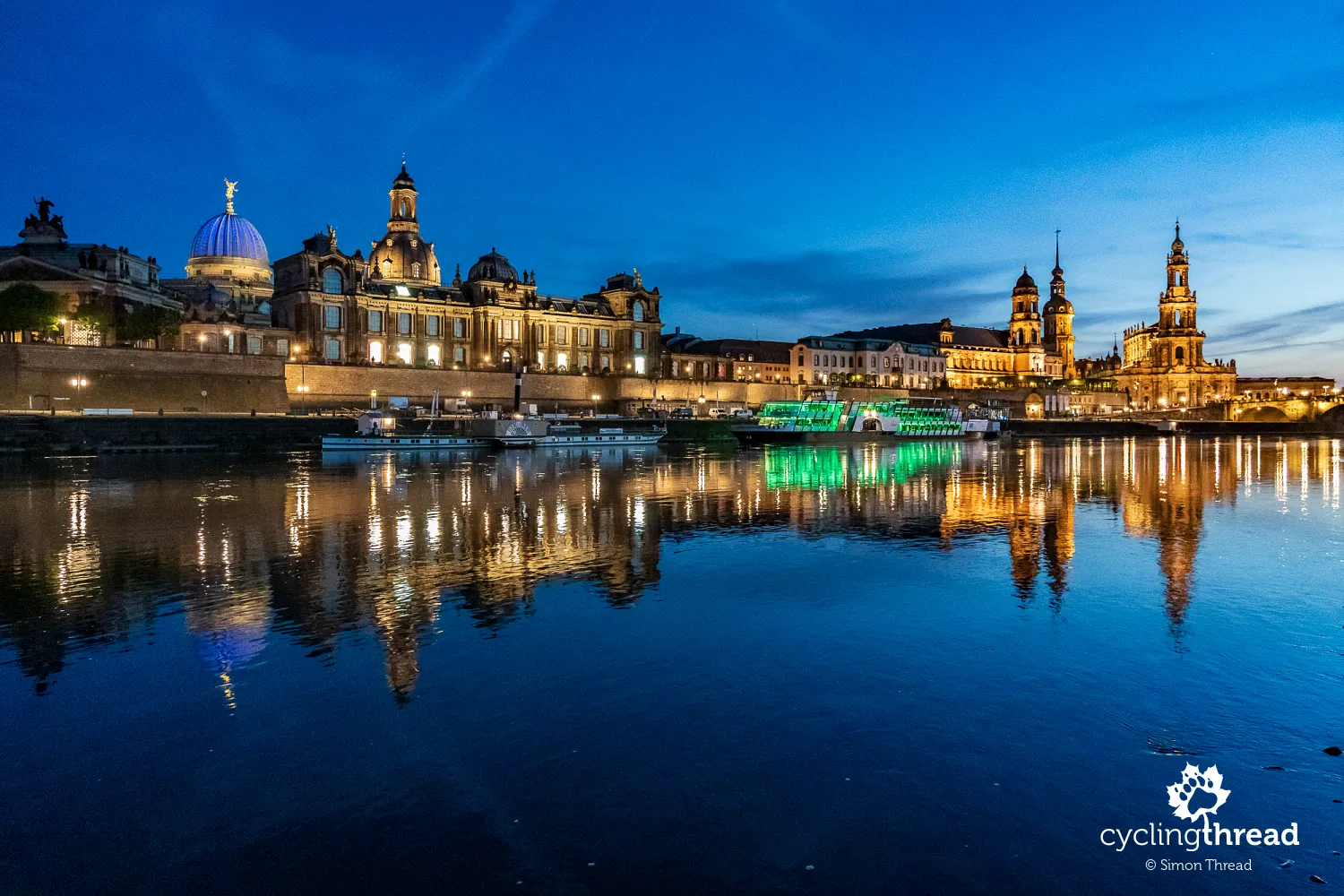
Military history, cars, culture, and transport
Dresden also offers lesser-known attractions, which we explored during our first trip through the Dresden Elbland region. One of the highlights is the German Military History Museum (Militärhistorisches Museum der Bundeswehr) - a modern, bold institution with a striking wedge-shaped entrance designed by Daniel Libeskind, presenting the history of armed conflict from a critical perspective. Another interesting experience is the Transparent Factory of Volkswagen (Gläserne Manufaktur), where luxury Phaetons were once assembled and where today electric Golfs are produced and the future of mobility is showcased. Also worth seeing is the Panometer Dresden - a giant 360° panorama created by Yadegar Asisi inside a former gas holder, immersing visitors in the world of historic Dresden. Completing the city’s unique offer is the German Transport Museum (Verkehrsmuseum Dresden) - a surprising combination of the baroque Johanneum palace and a modern exhibition on the history of road, rail, water, and air transport.
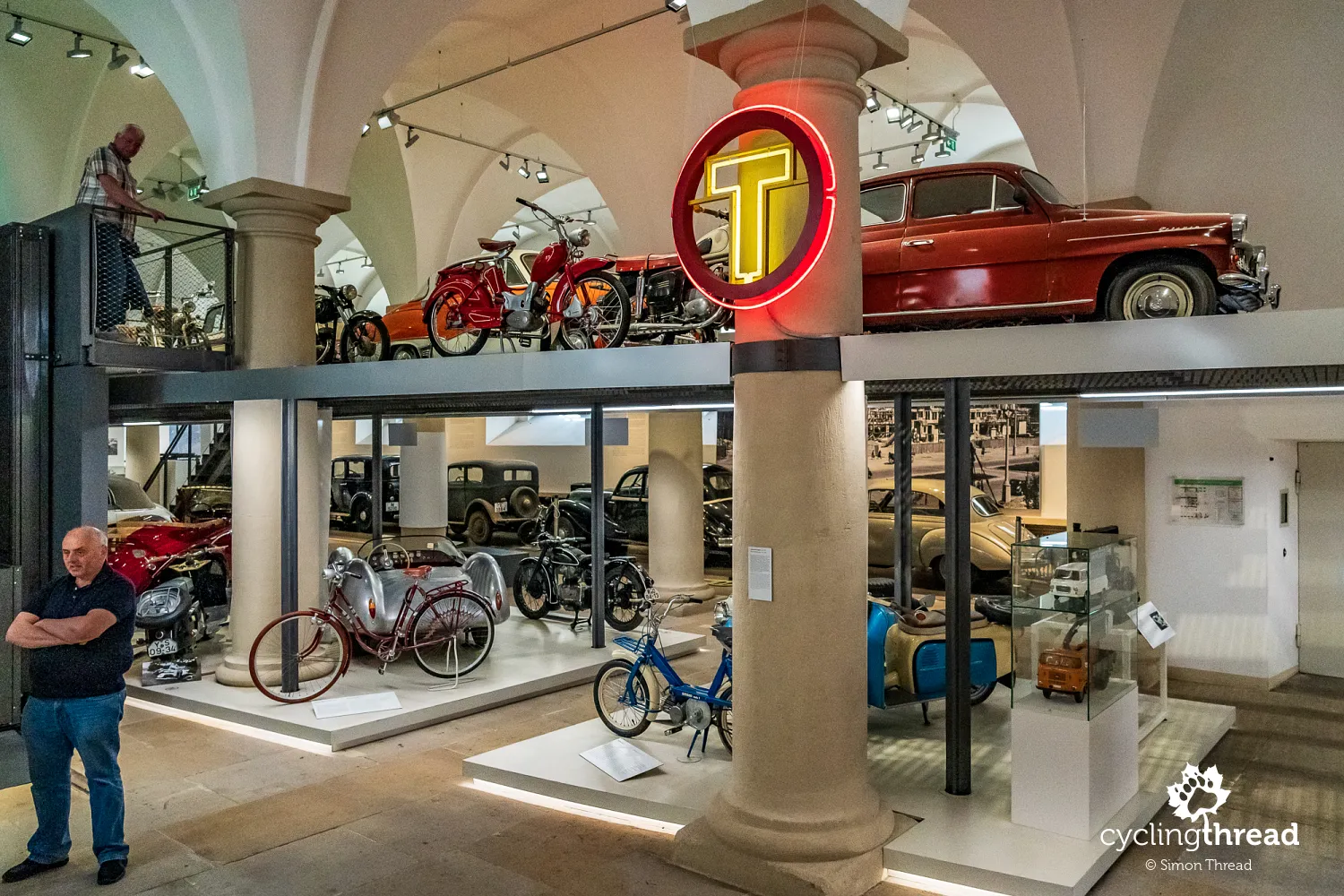
First kilometers along the Elbe Route
The first kilometers along the Elbe Cycle Route lead through riverside Dresden - modern residential areas, small industrial zones, and then, gradually, more and more greenery and open space, with the river becoming the main guide. Sometimes we cycle right next to the water, sometimes at a distance, but the lazy rhythm of the Elbe is always within view. There's a noticeably large number of cyclists - of every kind imaginable. From locals heading to school or work to visitors enjoying shorter or longer cycling adventures. On city bikes, mountain bikes, road bikes, gravel bikes - and of course, touring bikes, both electric and traditional.
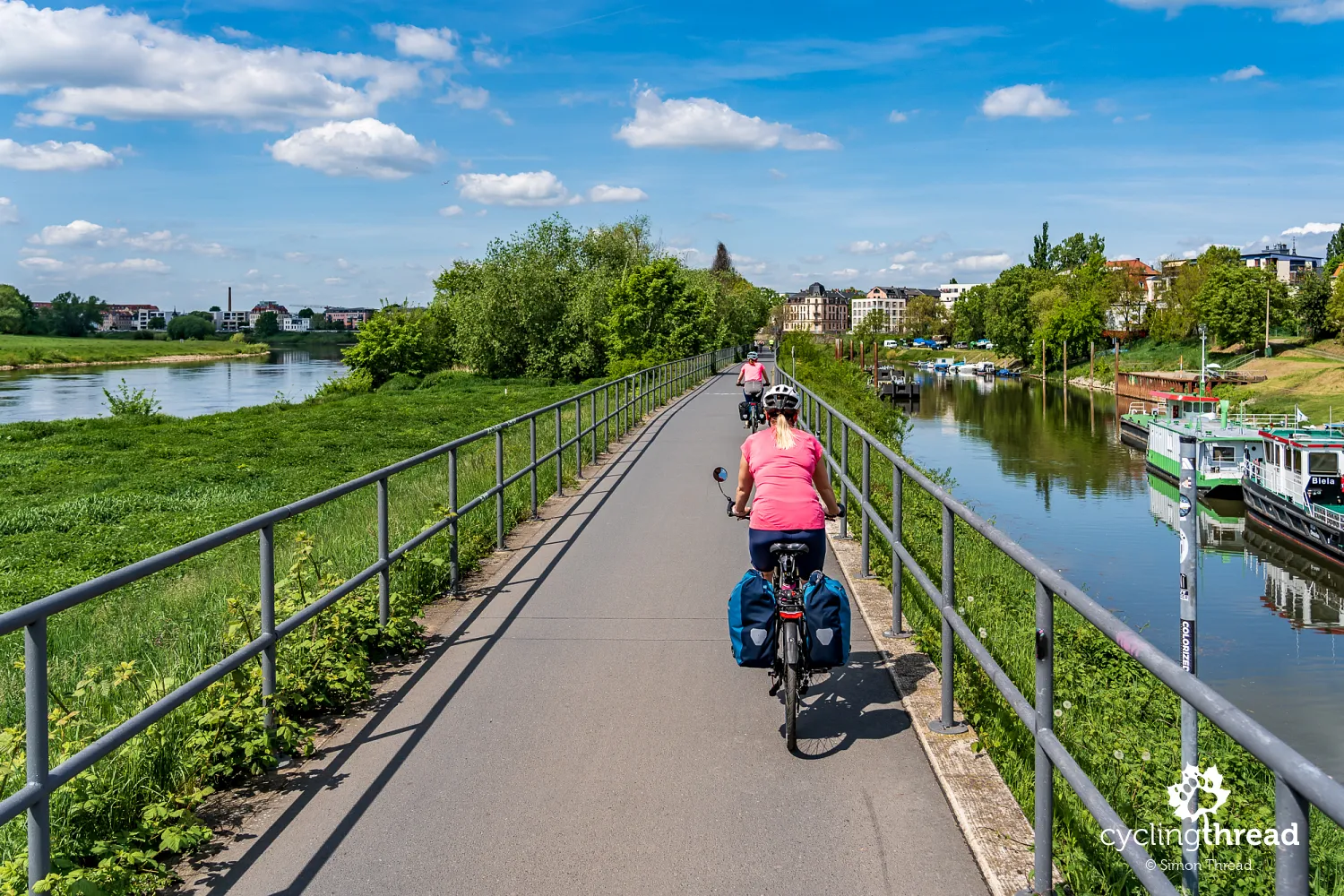
Around Dresden it’s hard to build up speed - interesting spots keep tempting you to stop. Just outside the city lies Radebeul, home to the Karl May Museum - dedicated to the author whose Wild West novels shaped generations of cycling tourists fascinated by the American frontier. A bit further on is Altkötzschenbroda - a charming historic district of Radebeul known for its intimate character and artistic vibe. Narrow lanes, restored half-timbered houses, low-lying vineyards, and local galleries create a peaceful setting ideal for an afternoon stroll. At its heart is a quaint square with small cafés and wine bars offering regional wines from the Elbe valley. Altkötzschenbroda regularly hosts festivals, markets, and cultural events, attracting both locals and tourists in search of authentic Saxon atmosphere. It lies almost directly on the route - definitely worth a detour to soak in some of that laid-back charm.
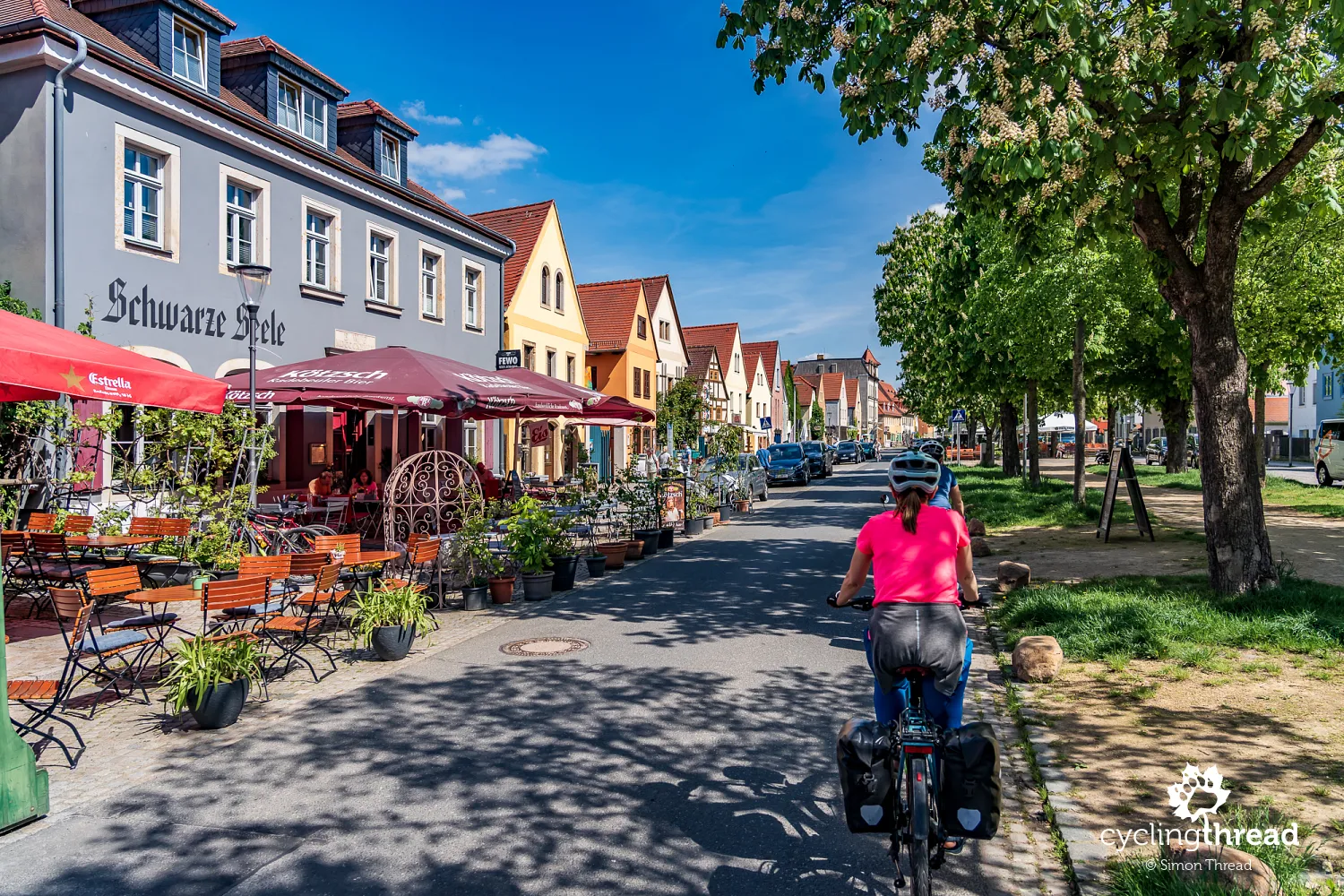
Scenic setting at Wackerbarth Palace
Altkötzschenbroda also offers the shortest and probably most convenient detour from the route to Wackerbarth Palace, also located in Radebeul. This baroque estate, with its beautifully maintained garden and hillside vineyards, is not only a historic residence but also a modern winery and a hub of wine tourism - perhaps even a symbol of Saxony. You can join a wine tasting, enjoy a glass at the summer terrace restaurant, tour the cellars, or simply relax in the garden with a view of the vines. The palace is named after Christian von Wackerbarth - a diplomat and patron of the arts at the court of Augustus the Strong - and to this day it blends the elegance of the past with the vibrant culture of Saxon winemaking. Truly a place worth a short detour from the main route.
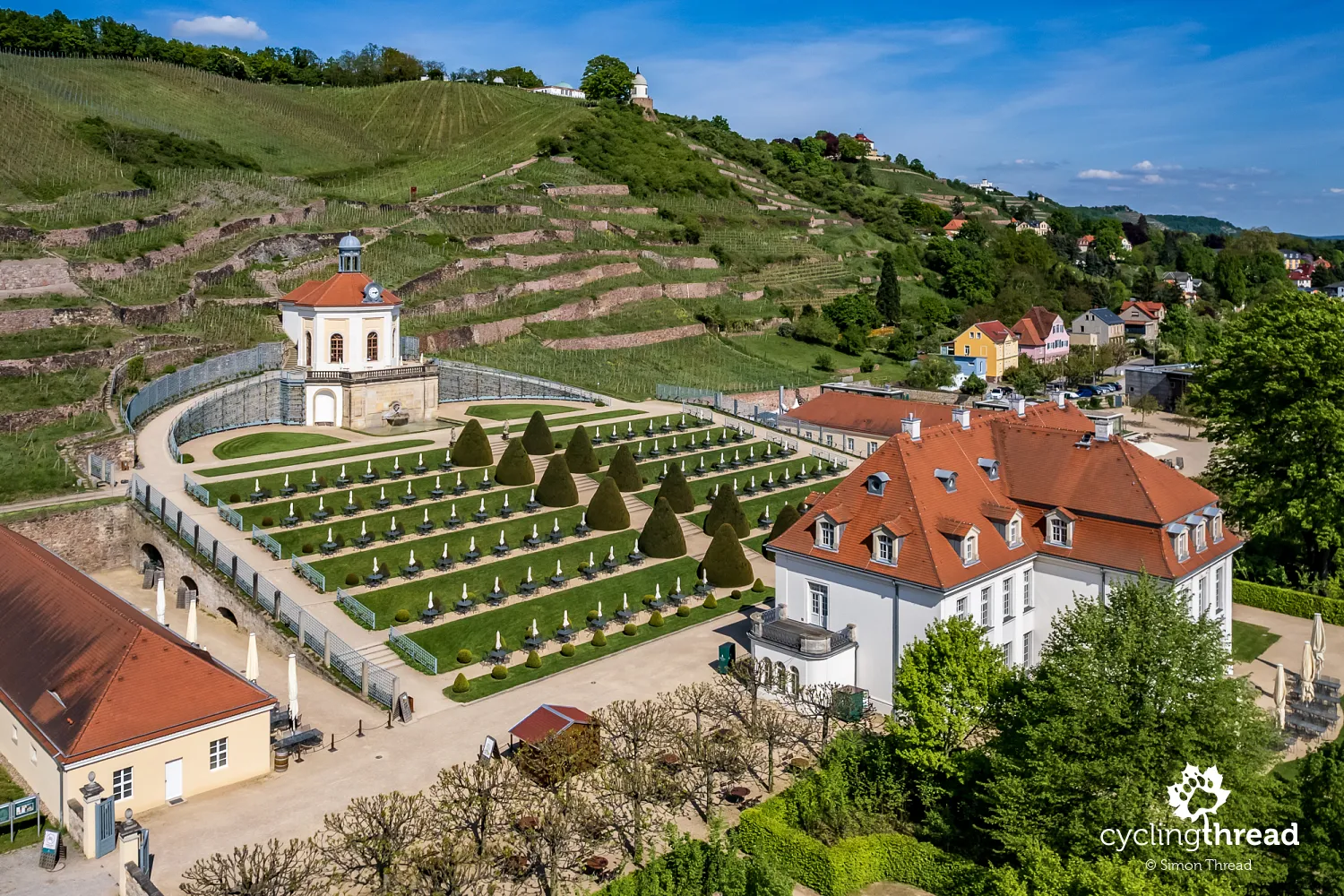
A full mosaic of surfaces under our wheels
Then it's a straight ride to wonderful Meissen. But before we get to the town itself, it’s worth talking about the cycling paths - because even on this short stretch, you get a good sense of what riding Elberadweg is really like. We were quite surprised by how often the Elbe Route runs along... cobblestones! Decent ones - well laid, small, and easy to ride - but cobblestones nonetheless. And when the cobbles ended, we often found ourselves on behaton - interlocking concrete pavers, often used on roads built atop the Elbe’s flood embankments. That’s the character of this 30-year-old Queen of the Elbe - three decades of legacy that aren't so easily transformed into smooth, modern asphalt paths. And yet - surprisingly - we quickly got used to this mosaic of surfaces, and maybe even... started to enjoy it?
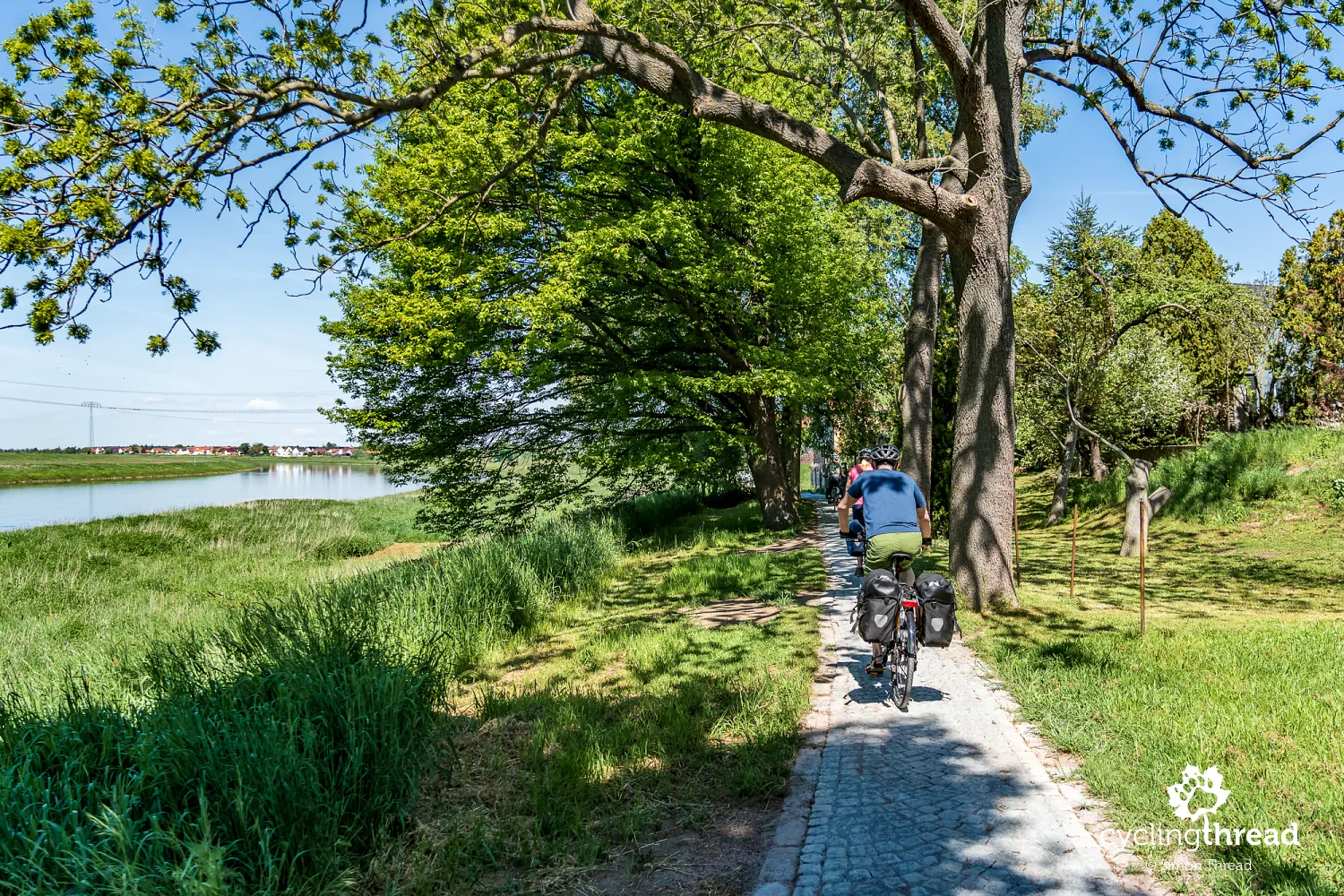
Caspar David Friedrich painted the Elbe too
The section of the Elbe between Dresden and Meissen winds lazily through gentle hills, vineyards, and baroque towns - it feels almost like a painting. It’s no surprise that these landscapes inspired Caspar David Friedrich, master of German Romanticism, who could draw out deep emotion and spiritual reflection from seemingly ordinary views. Though he’s best known for his paintings of mountains, seas, and solitary figures against endless horizons, the Elbe valley - with its soft light, morning mists, and quiet river - was also a space of contemplation for him. Today, as you cycle this stretch of Elberadweg, it’s easy to feel the same stillness and focus that Friedrich so powerfully conveyed in his works.
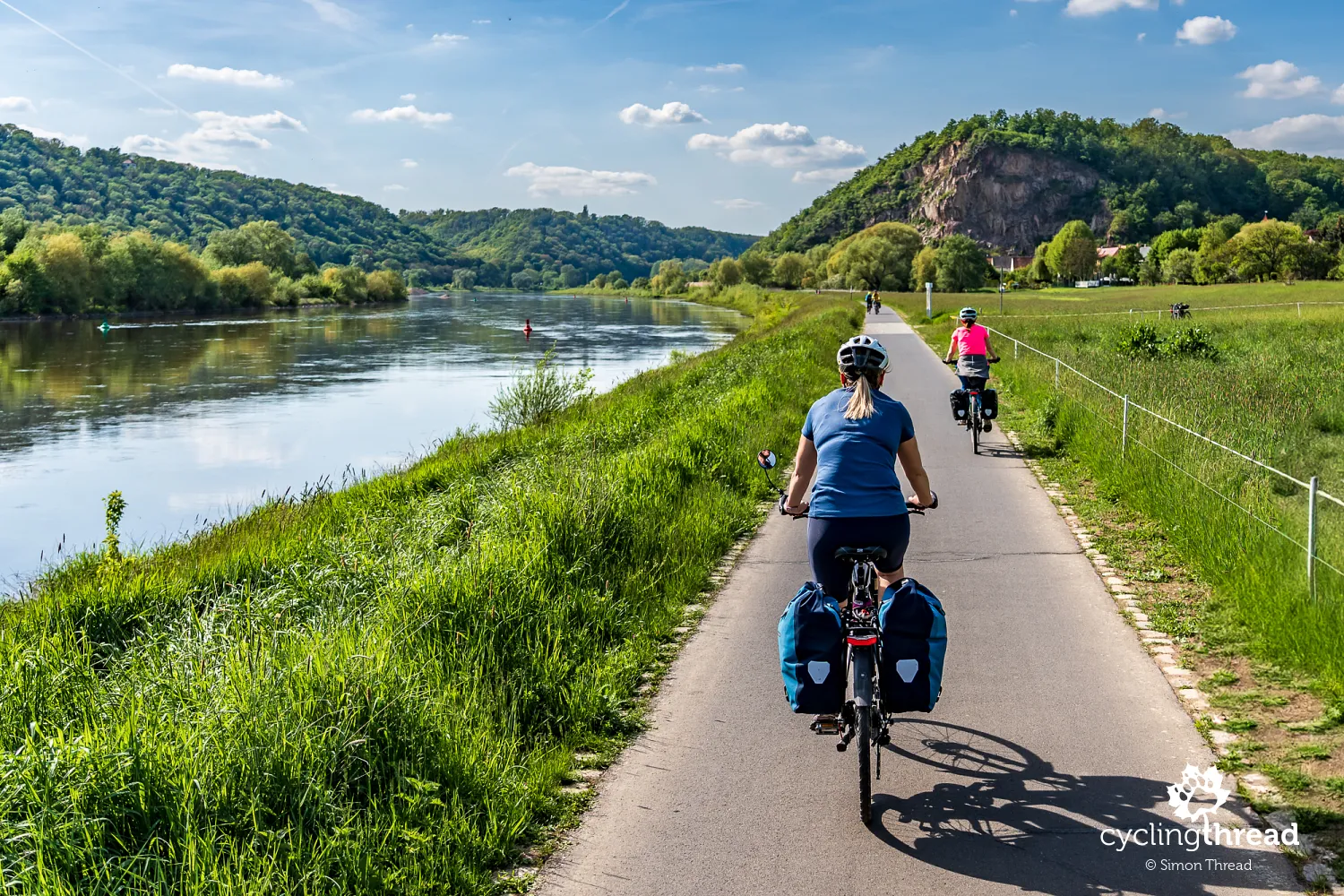
Walpurgis Night at the castle in Meissen
The view of Meissen from the narrow pedestrian-and-bike bridge that carries Elberadweg is undoubtedly one of the most beautiful in Germany. The Old Town rises gradually along cobbled streets leading up to Albrechtsburg Castle. This majestic fortress towers over the city - both elegant and imposing, with its distinctive spires and steep roofline that seems to slice through the sky. It was here that European porcelain was born - the castle housed the first workshop, which eventually gave rise to the famous factory on the town’s outskirts. From the castle’s viewpoints, the panorama is enchanting - half-timbered houses, narrow alleyways, and cozy wine taverns create an atmosphere that invites you to linger. Meissen delights with its details - ornate facades, sculptures, historic plaques, and a relaxed rhythm of life that catches on quickly.
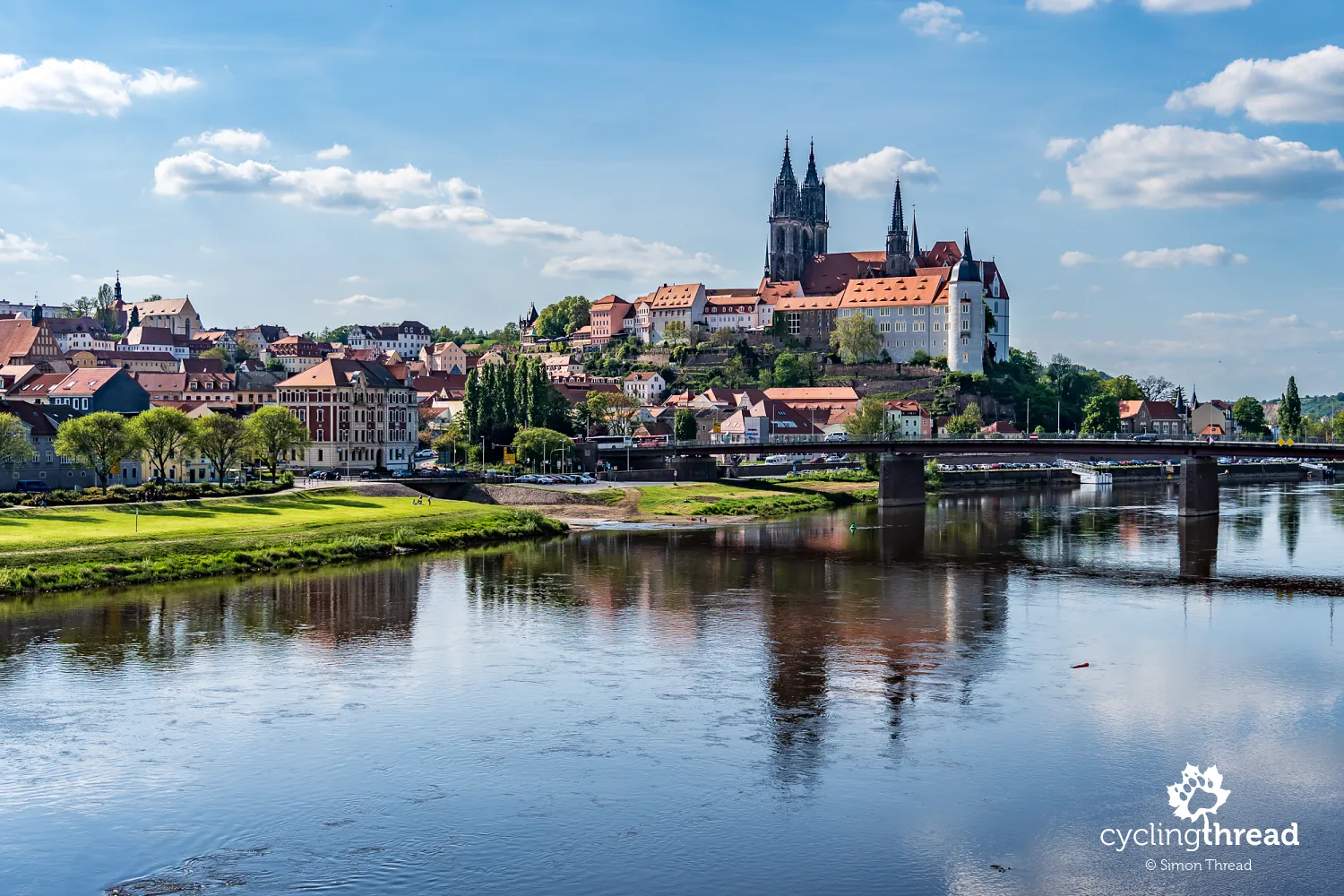
Our climb to the castle and to the Cathedral of St. John and Donatus - an integral part of the castle complex - followed a winding cobbled road, almost like a mountain serpent. At the top, a high stone bridge awaited us, right next to a terrace restaurant, and beyond it - the castle courtyard. There we stumbled upon a surprise: Germans were celebrating Walpurgis Night, the traditional spring festival held on the night of April 30th to May 1st. In Saxony and other regions, it’s marked by outdoor events - with bonfires, witch costumes, live music, and a symbolic farewell to winter. The castle courtyard was filled with festively dressed visitors, stalls were set up, the scent of mulled wine and grilled sausages filled the air, and the first notes of a concert echoed from the stage.
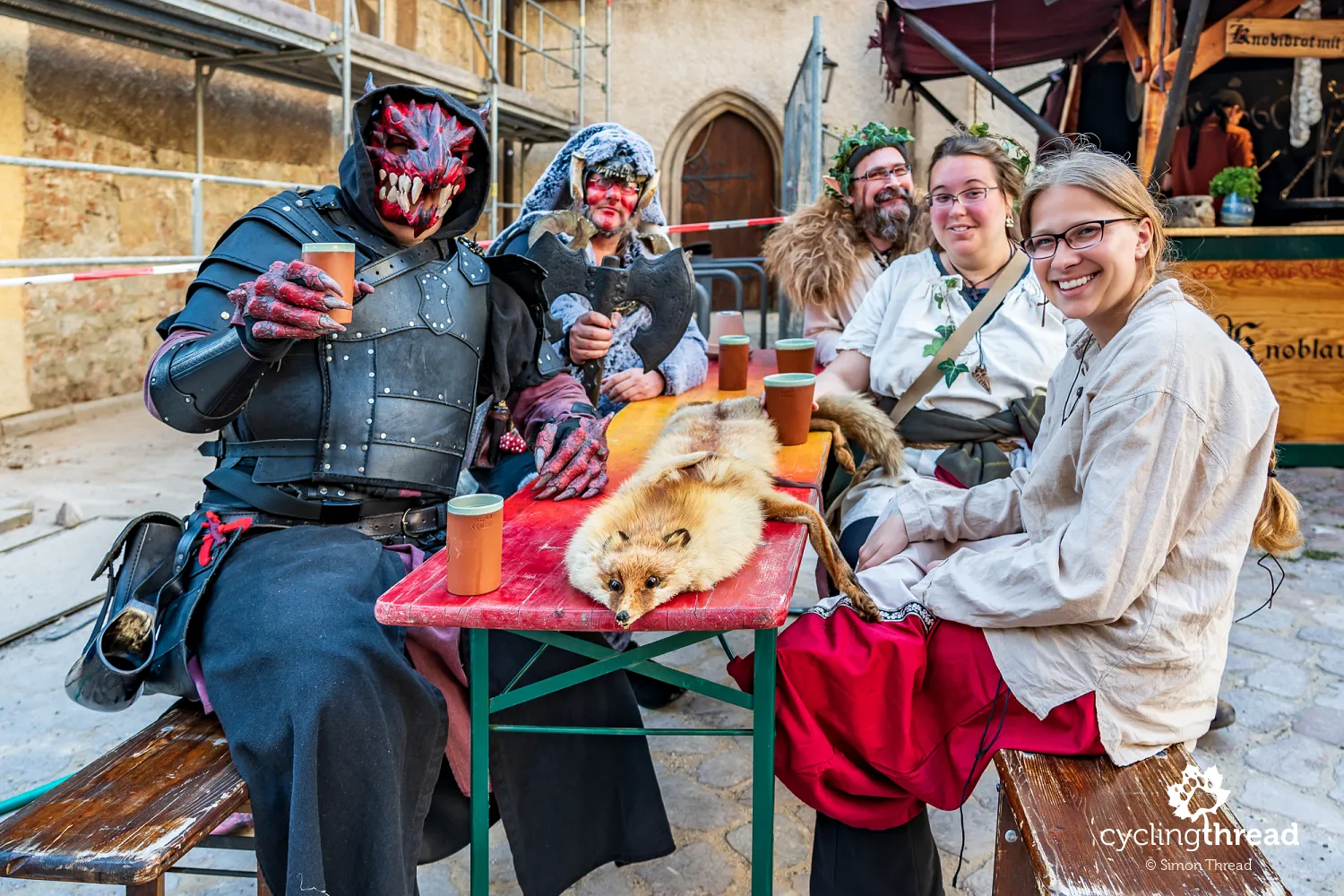
A perfect ending to the day by the Elbe
As the day drew to a close, the sky was awash in the warm, vivid light of a May sunset. In such picturesque conditions, we covered the final kilometers of our first cycling day, squinting into the sun reflecting off the Elbe’s surface. We were slowly leaving the Dresden Elbland behind, passing the last vineyards of Saxony’s wine region - one of the smallest in Germany, yet deeply rooted in the country’s wine culture. The last few hundred meters took us past the Goldkuppe hill - one of the most recognizable features along the river, offering a view that was named one of the most beautiful on the Elbe in 2020. Just before the hill was our guesthouse - run by a family that has been growing grapes and making local wine for decades.
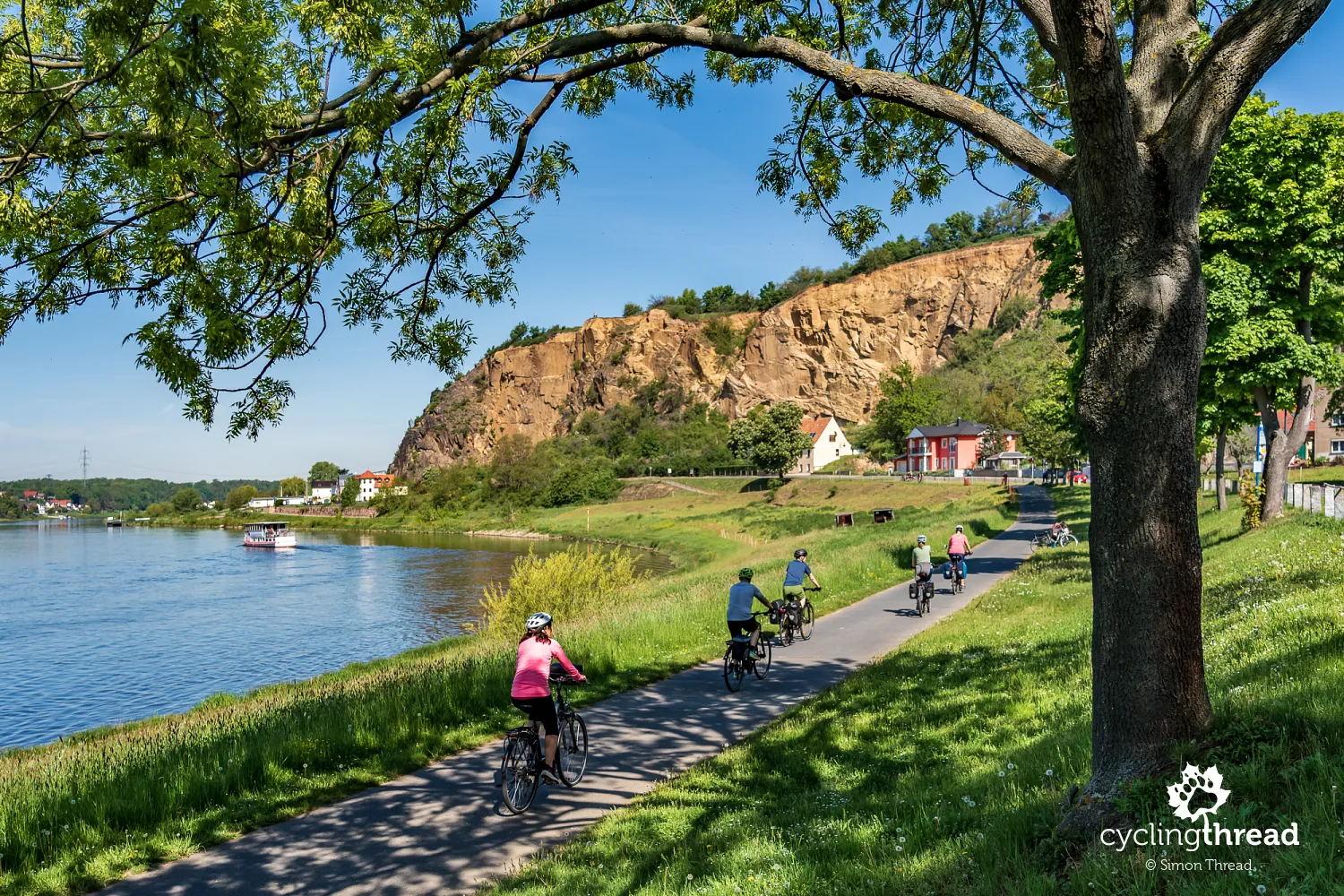
The best overnight stay on the Elbe Cycle Route
This was without a doubt our best overnight stay of the entire trip. After a peaceful night in rooms overlooking the Elbe and a quick taste of the local wines with a "winemaker's platter" prepared by the hosts, the real highlight came the next morning: a small jar labeled Wein-Gelee. This wine jelly, made from local grapes and gelling sugar, turned out to be the star of breakfast. Spread on fresh bread, it tasted unlike anything else - sweet, aromatic and full of regional character. We hoped to find it later in Magdeburg as a souvenir, but even in the biggest supermarkets, no one had heard of it. So if you stay here and fall in love with it too, make sure to buy a jar right at the vineyard - you won't regret it.
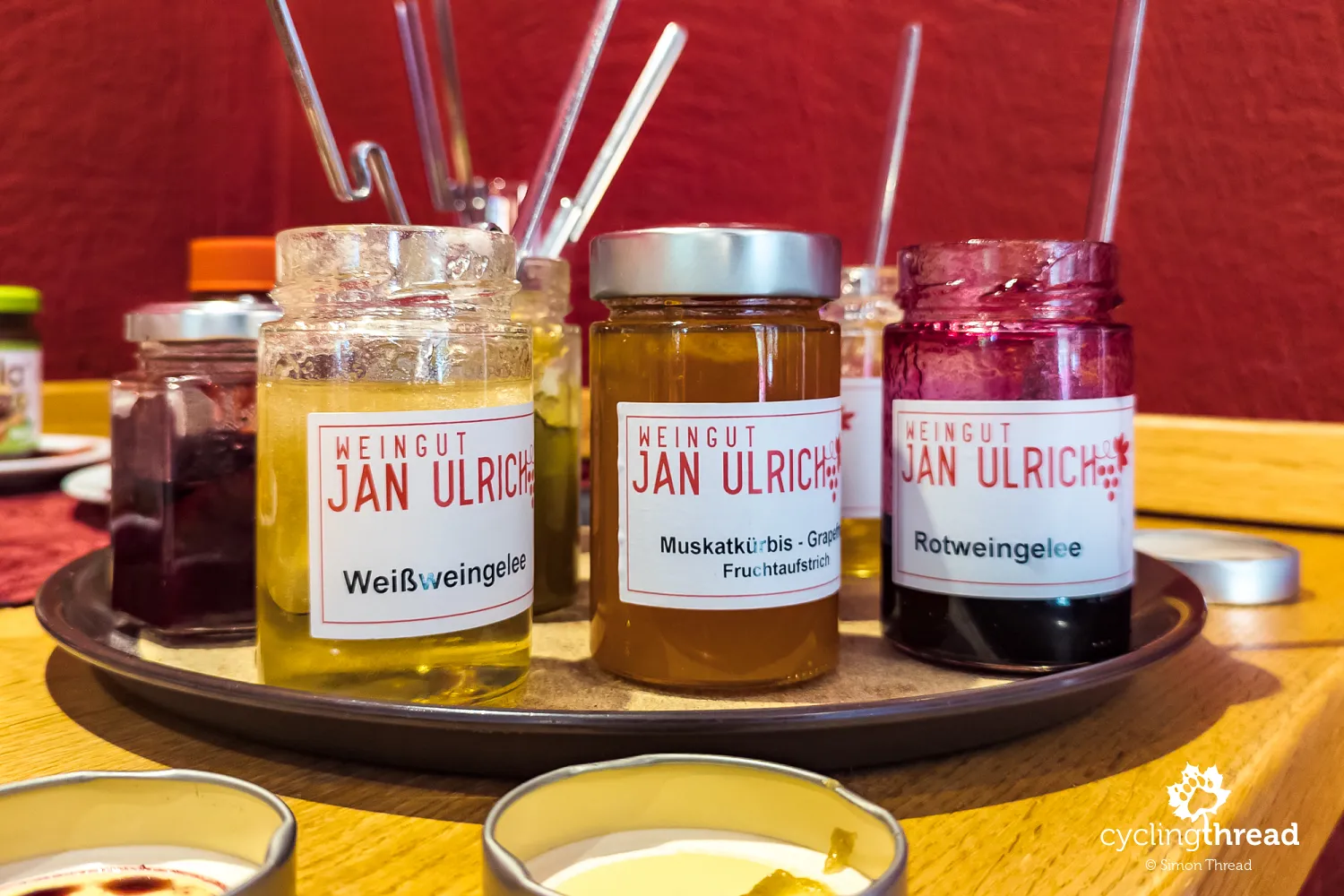
Schloss Seußlitz just a few steps off the route
Just around the corner, behind the rocky edge of the Goldkuppe hill, lies the baroque Schloss Seußlitz, surrounded by terraced gardens with views of the Elbe. Once the summer residence of the bishops of Meissen, this elegant palace catches the eye from afar. Built in the late 17th century by renowned architect Wolfgang George Hirschfeldt, its design is reminiscent of French residences from the era of Louis XIV. Today it functions as a registry office and a venue for cultural events, but its courtyard and park are open to visitors. It’s well worth a quick stop - especially since it’s only a few hundred meters from the riverside cycle route.
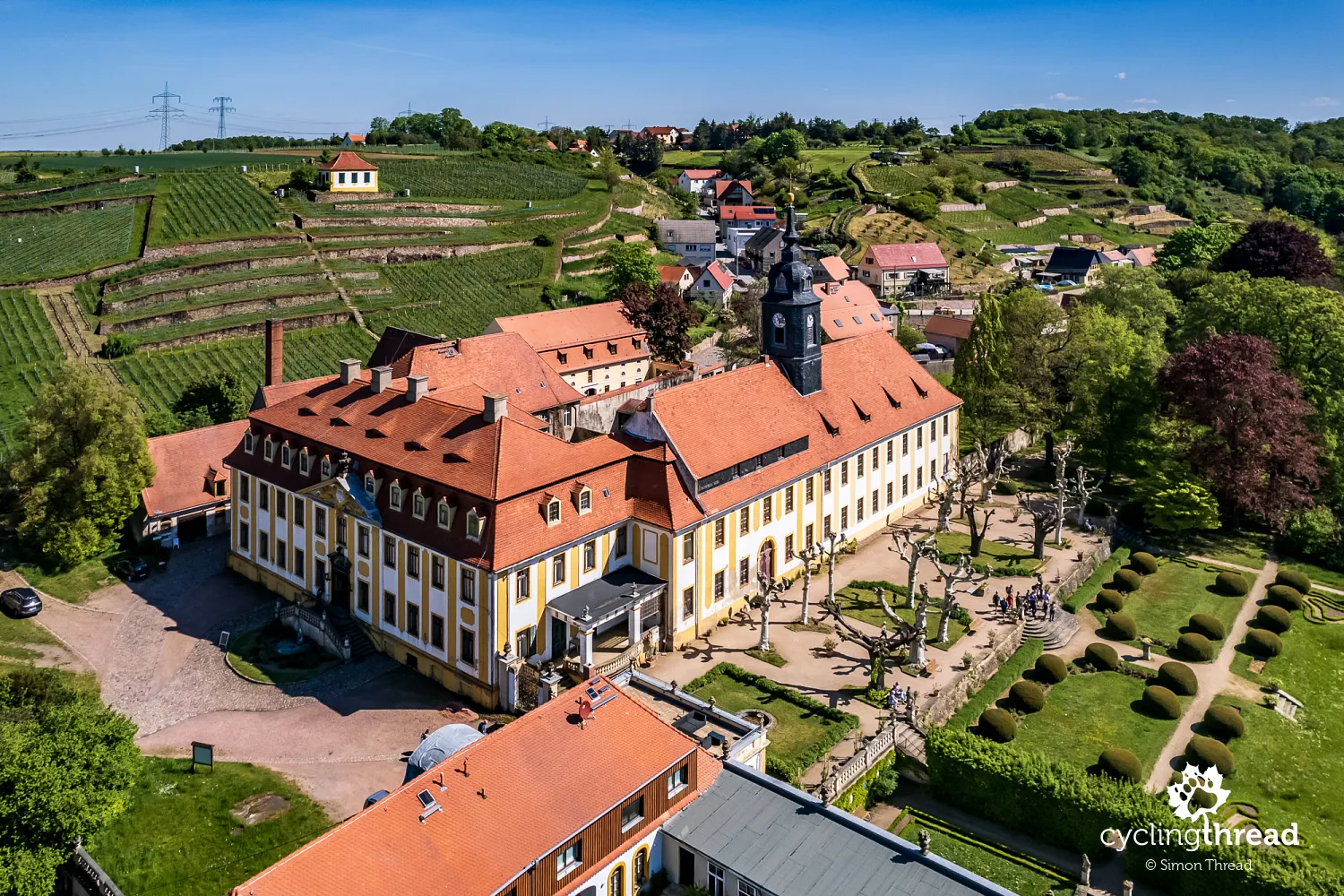
A route with a wonderfully gentle character
In this area, the steep slopes and high cliffs of the Dresden Elbland come to an end. From here, the route takes on a calmer, more relaxed character that continues at least until Magdeburg. And although most of the route is flat, that doesn’t mean it’s boring - the Elbe Cycle Route changes directions and surface types often enough to keep things interesting. You’ll notice more and more expansive floodplains - wide, flat terraces created by centuries of river overflows. These open landscapes not only give the scenery a sense of space but also remind you of the natural rhythm of the Elbe, which has shaped this region for generations.
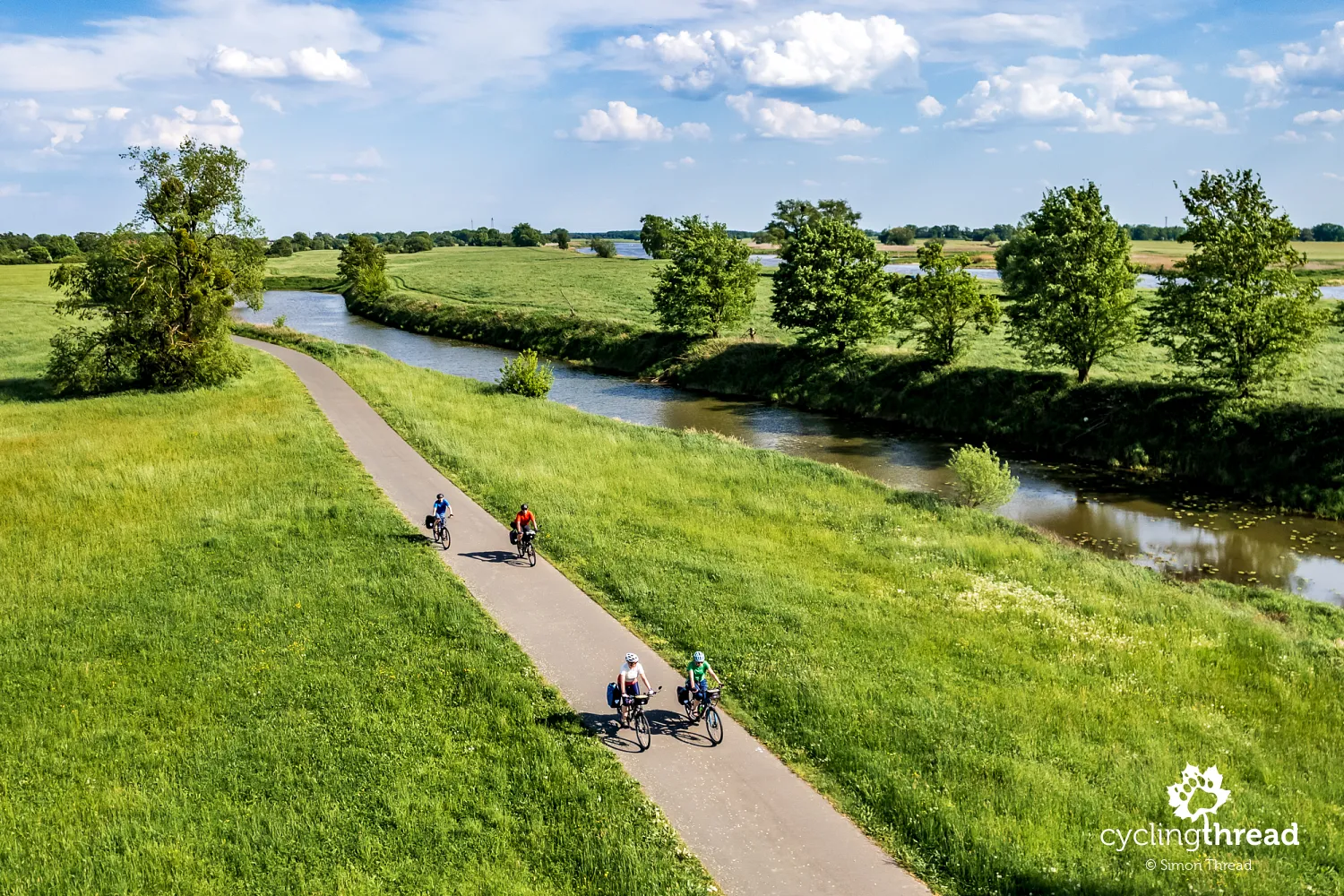
Cycle paths on both sides of the river
One of the most distinctive and rare features of the Elbe Route - and something not often seen on other river routes in Europe - is that Elberadweg runs along both banks of the river for much of its length. For cyclists, this offers an incredibly practical flexibility when planning a route - you can freely choose the side that suits you better on any given day: based on sunlight, wind, surface type, or sights along the way. Paths on both banks also mean it's easy to create loops without having to ride the same way back - a great option for both day-trippers and those on longer journeys. Ferry crossings play an important role here too - often a memorable experience in themselves, and a pleasant break with a scenic river view.
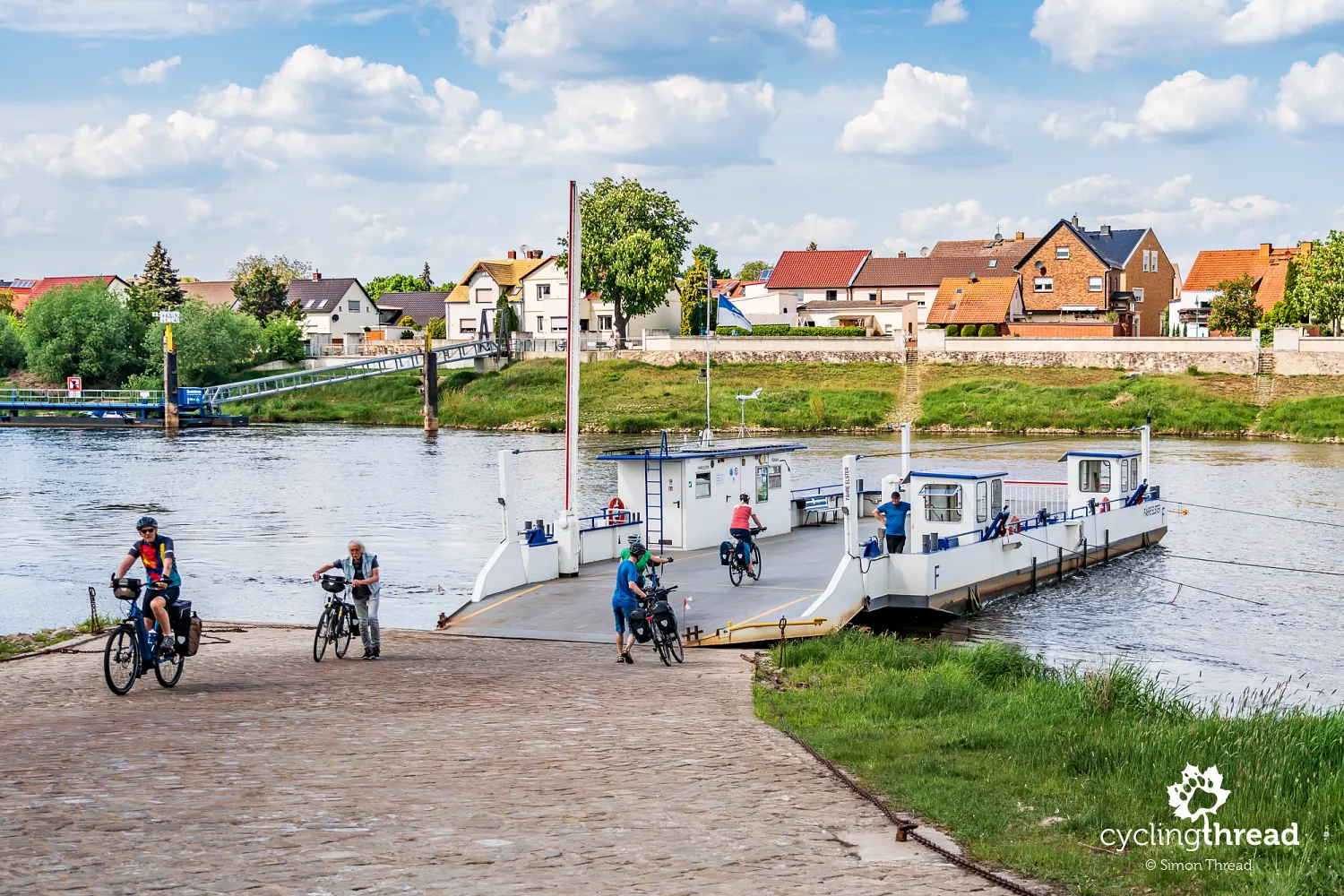
Our five-day route along the Elbe was shaped by the shortest stretches between towns and riverside spots we wanted to visit. As a result, we ended up with a fairly random mix of roads and surfaces on both sides of the river - which allowed for an unbiased and honest evaluation of the overall quality of Elberadweg. Indeed, most of the route was made up of excellent, paved bike paths offering high comfort. What’s more, many of these paths run through scenic landscapes - right by the river - giving Elberadweg a very natural, organic feel. It’s not just the smooth surfaces that impress, but also the way the route is integrated into the landscape - without unnecessary barriers or detours. This is exactly the kind of design cyclists look for when exploring new places at a relaxed, enjoyable pace.
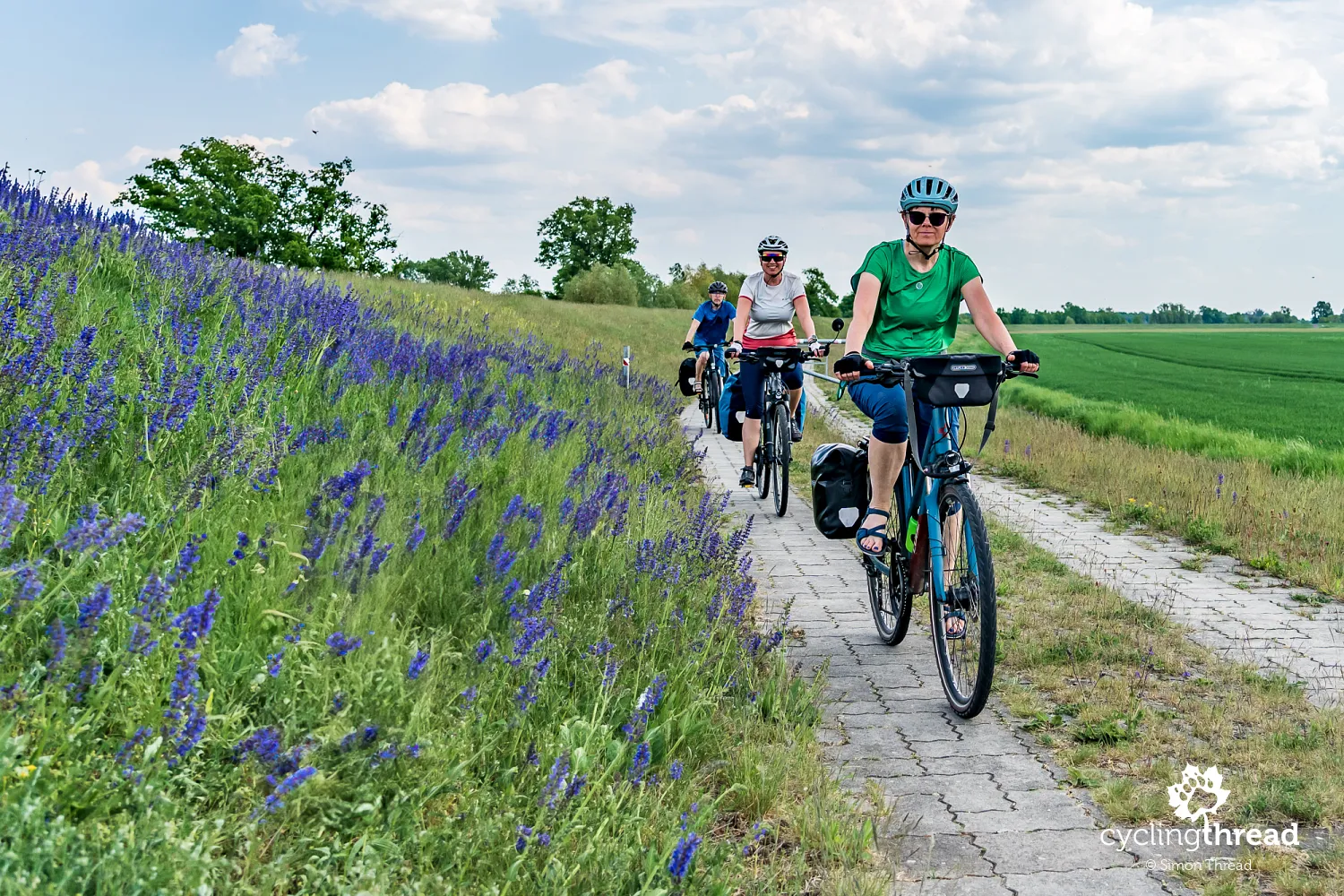
Steel industry and a historic encounter
We saw the towns of Riesa and Strehla from the opposite bank of the Elbe - that’s just how our route unfolded, and we didn’t spot enough attractions to justify changing course. Still, it’s worth knowing that Riesa was for decades a major center of heavy industry - especially steel - something still visible in the vast grounds of the former Stahl- und Walzwerk plant. A bit further along and practically next door, the town of Strehla is one of the oldest in Saxony - its origins go back to the early Middle Ages. Strehla has a quiet, provincial feel, but it earned its place in history as the actual site of the first meeting between American and Soviet troops in April 1945 - even though the official narrative credits nearby Torgau. It was in the area around Strehla that soldiers from the U.S. 69th Infantry Division made first contact with Red Army units, a day before the symbolic handshake on the bridge in Torgau. For those cycling the Elbe, this is a lesser-known but fascinating episode from the end of World War II that’s worth keeping in mind.

Germany's first cycling church
On the way to Torgau, our attention was caught by the church in Wessnig - or more precisely, by the yellow sign in front of it. It marks a German Radfahrerkirche - a cycling church. This one, located along Elberadweg, was the very first in Germany to be officially opened to cyclists, back in 2003. It means the church stays open most of the day, offering travelers a moment of peace, a shady spot to rest, a place to leave their bikes, and sometimes access to water or informational leaflets. It's a practical and symbolic gesture - an invitation to all those who choose to travel slower and more mindfully, just like Elberadweg encourages you to do.
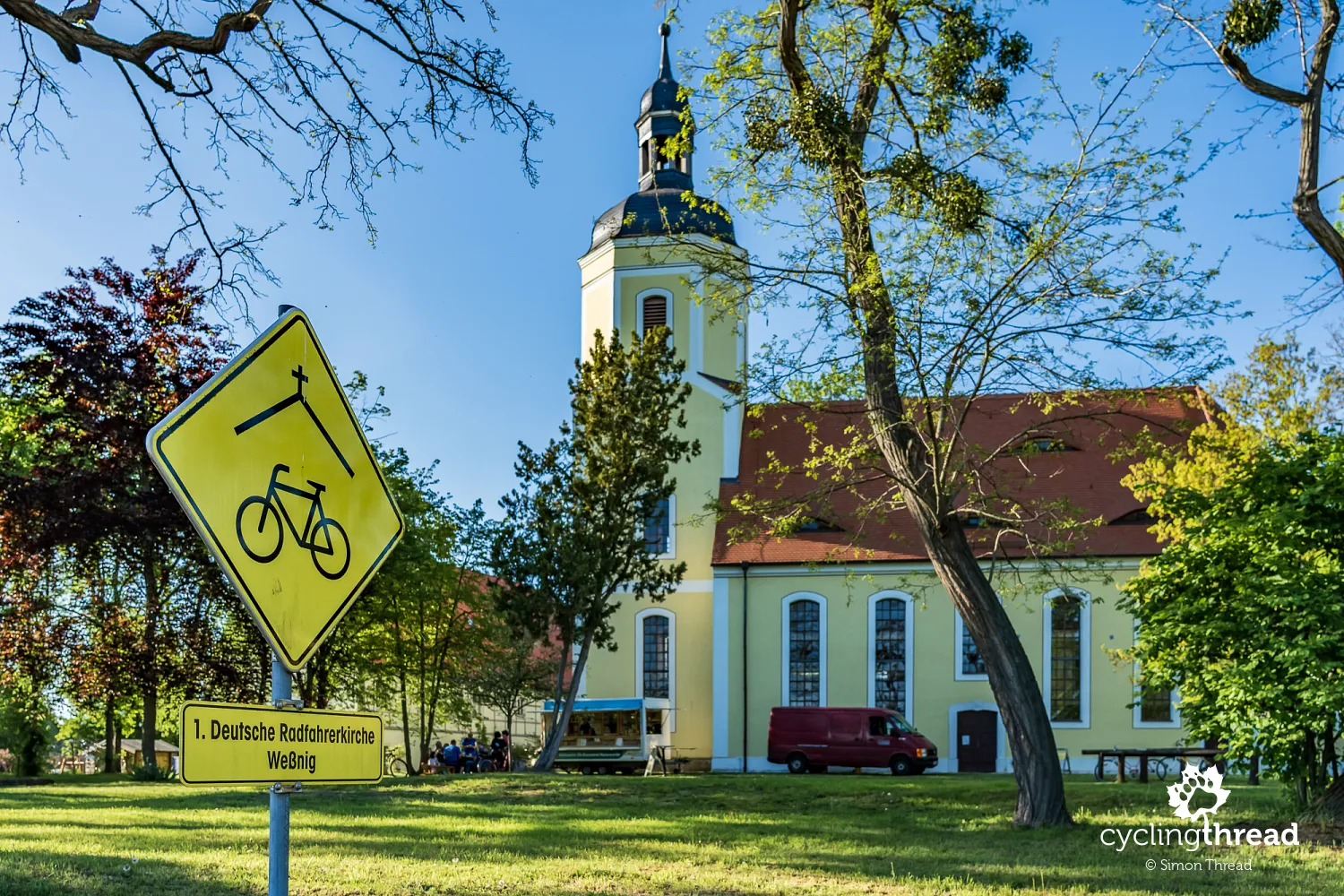
Cycling through the Middle Elbe Biosphere Reserve
One of the biggest highlights of Elberadweg between Dresden and Magdeburg is the Middle Elbe Biosphere Reserve (Biosphärenreservat Mittelelbe). The route passes through Central Europe’s largest stretch of riparian forest, covering around 430 km². This is an area of exceptional ecological value, home to some of the last natural floodplain woodlands in the Elbe basin. The reserve enchants with its riverside meadows, quiet oxbow lakes, and centuries-old oaks - the landscape seems to shift with every bend of the river. Over 1,000 plant species, 250 bird species, 130 types of bees, and 50 dragonfly species live here. The reserve was designated a UNESCO biosphere site back in 1979, making it one of the first in Germany. Its exemplary blend of nature conservation and sustainable tourism makes it an ideal destination for a peaceful, nature-focused cycling journey.
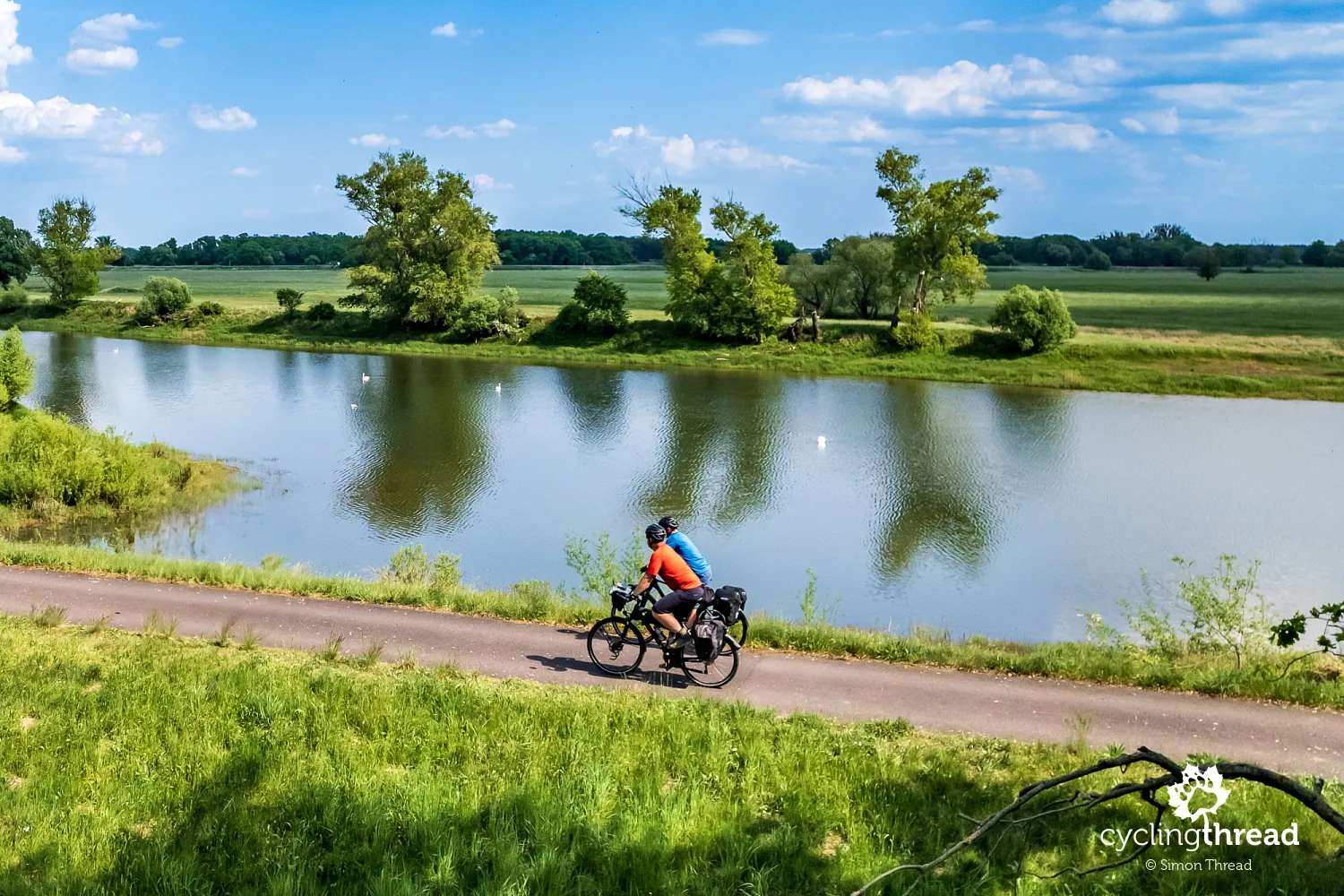
Centuries of history in quiet Torgau
Before entering the center of Torgau, it's worth taking a special spiral ramp leading up to the bridge over the Elbe - from there, you get a perfect view of the hill crowned by the majestic Hartenfels Castle, as well as the site commemorating the meeting of American and Soviet troops in April 1945. A memorial plaque and small monument are located on the eastern bank, right by the bridge, directly opposite the castle. Although the first contact between soldiers actually took place the day before, a bit further south near Strehla, it was Torgau that became the symbol of the event. The official ceremony took place here, captured in photos and film footage that was later seen around the world.
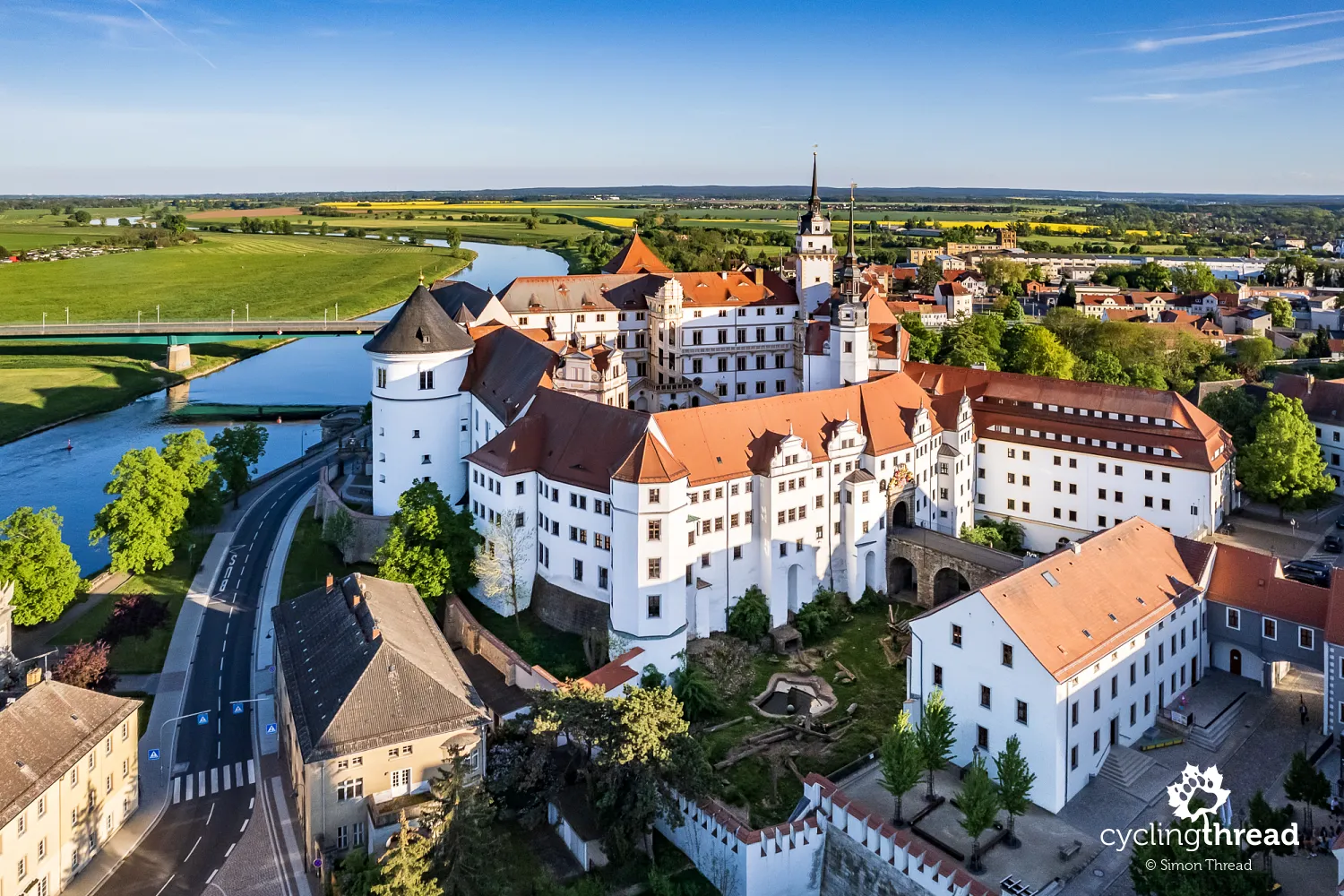
Torgau surprised us with its calm and remarkably intimate atmosphere for a town with such a rich past. At its heart lies a spacious square in front of the monumental town hall, whose Renaissance façade makes a striking impression and lends the center a sense of grandeur. It was hard to believe we didn’t come across any other tourists - just a handful of locals - and we had breakfast at a small bakery table in near silence, with no crowds and no rush. That peaceful feeling continued as we toured Hartenfels Castle, which towers over the cityscape. Today the castle houses a museum about the region’s history and Torgau’s role as a center of the Reformation and an electoral residence.
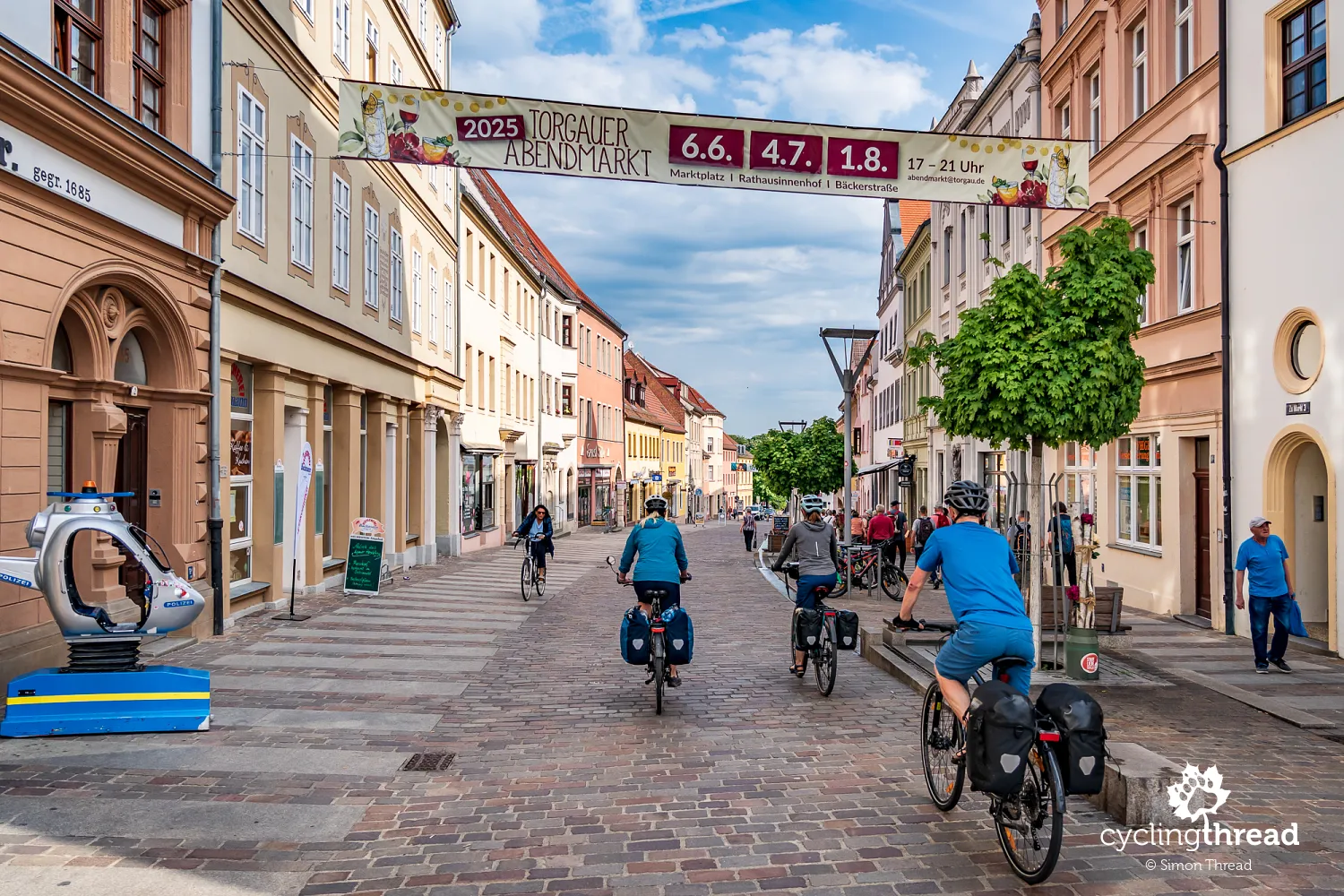
It’s worth knowing that Torgau played a key role in Reformation history - this is where Martin Luther died, and where his wife, Katharina von Bora, was buried. The town also served for a time as the seat of the Saxon electors, which explains the scale of Hartenfels Castle and the presence of the Schlosstreppe - an external spiral staircase considered one of the first self-supporting staircases of its kind in Europe. Torgau is also where, in the 16th century, the first Protestant church purpose-built for the new faith was opened - the castle chapel, consecrated by Luther himself. Walking through the quiet streets of the old town, you can feel the presence of the past - not in the form of grand reenactments, but as an authentic, understated thread of history woven into the buildings, squares, and façades.
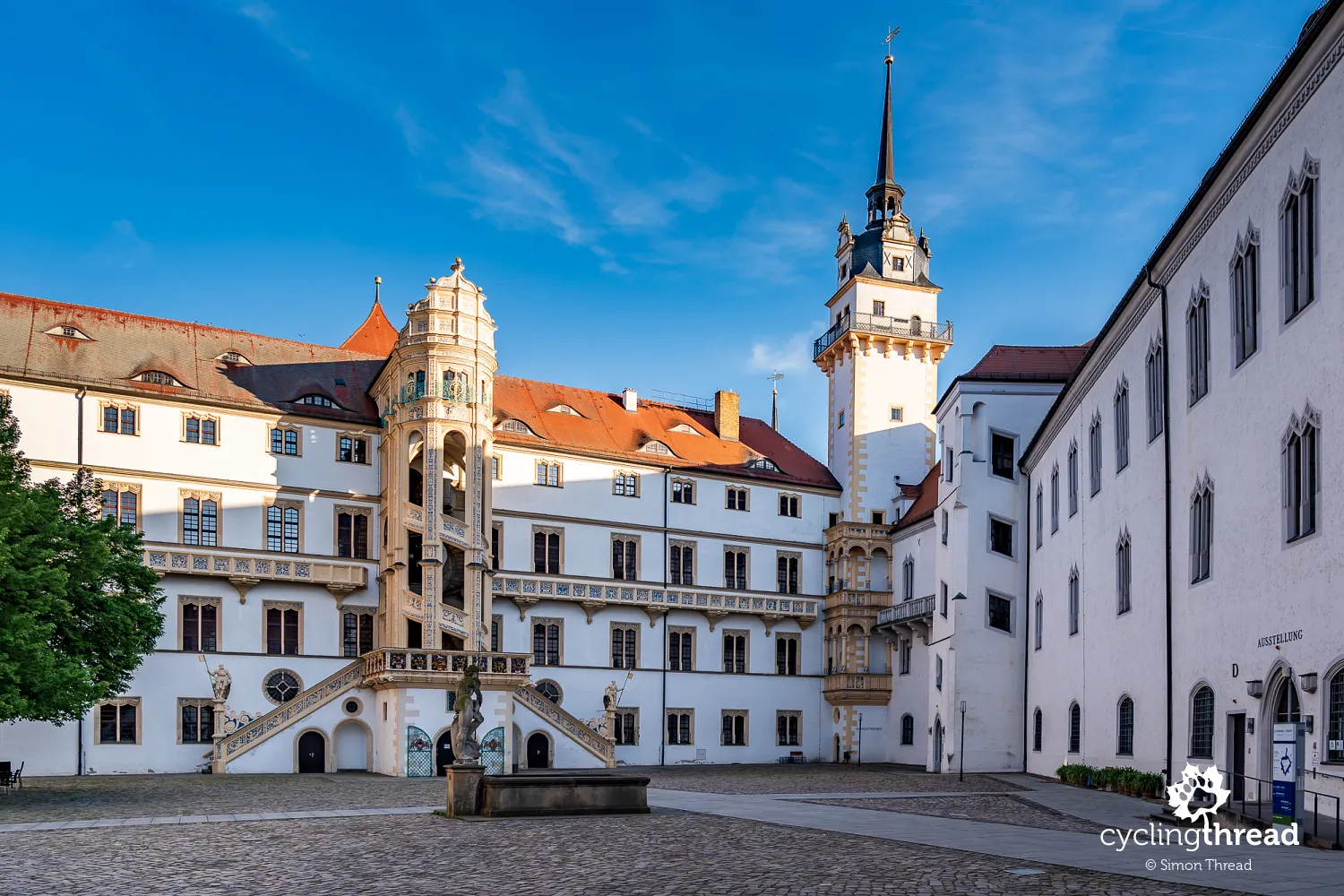
Oxbow lakes and floodplain forests along the Elbe
The next day along the Elbe unfolds almost entirely on quiet, secondary bike routes like the ones I mentioned earlier. The route often follows former river channels, which can surprise you with their location - appearing on the opposite side from where you’d expect the main river flow to be. I probably remember the section between Torgau and Wittenberg as one of the most peaceful, natural stretches of the entire route. For long stretches, the path leads through fields, meadows, and floodplain forests, where your only company might be cranes or deer darting across the way. Even rest breaks feel different here - not at a café or an information board, but under a tree, on a dike, with a view of the water and surrounding greenery.
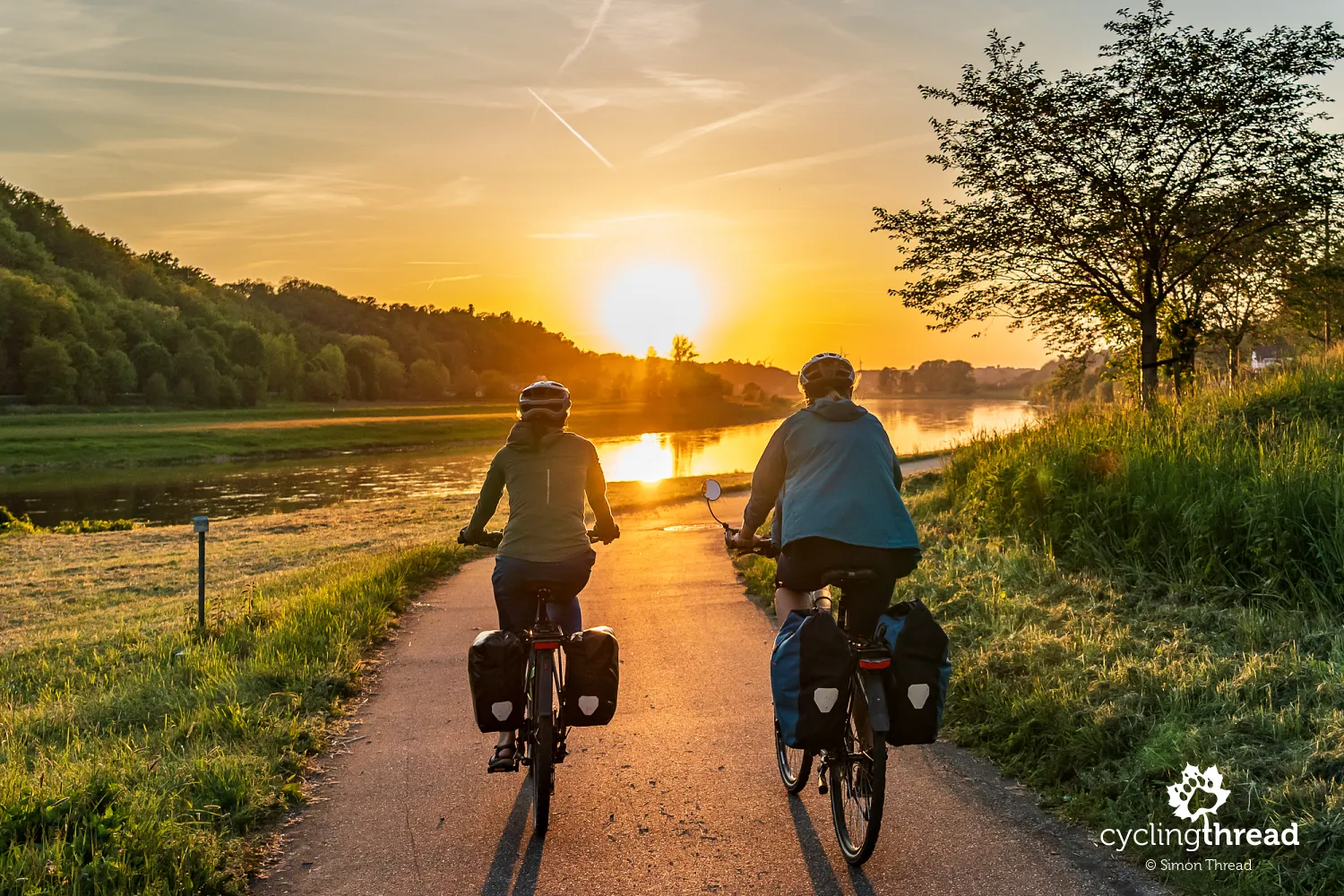
They don’t want walls - they want riverside identity
Just before reaching Wittenberg, we crossed to the right bank of the Elbe - taking a ferry in Elster. What we saw on the other side - long concrete flood protection walls right at the water’s edge - helped us better understand the banners we’d seen earlier bearing the slogan "Wir wollen keine Mauer" ("We don’t want a wall"). Their authors, residents of various towns in the Elbe valley, oppose the construction of these concrete barriers, which are planned to replace the more natural flood defences currently in place. They fear losing access to the river, damaging the landscape, and disrupting the local ecosystem. For many, the Elbe is more than a river - it’s part of their daily life and identity, an open space that shouldn’t be cut off by a wall. But the most fascinating chapter on this topic was still ahead of us.
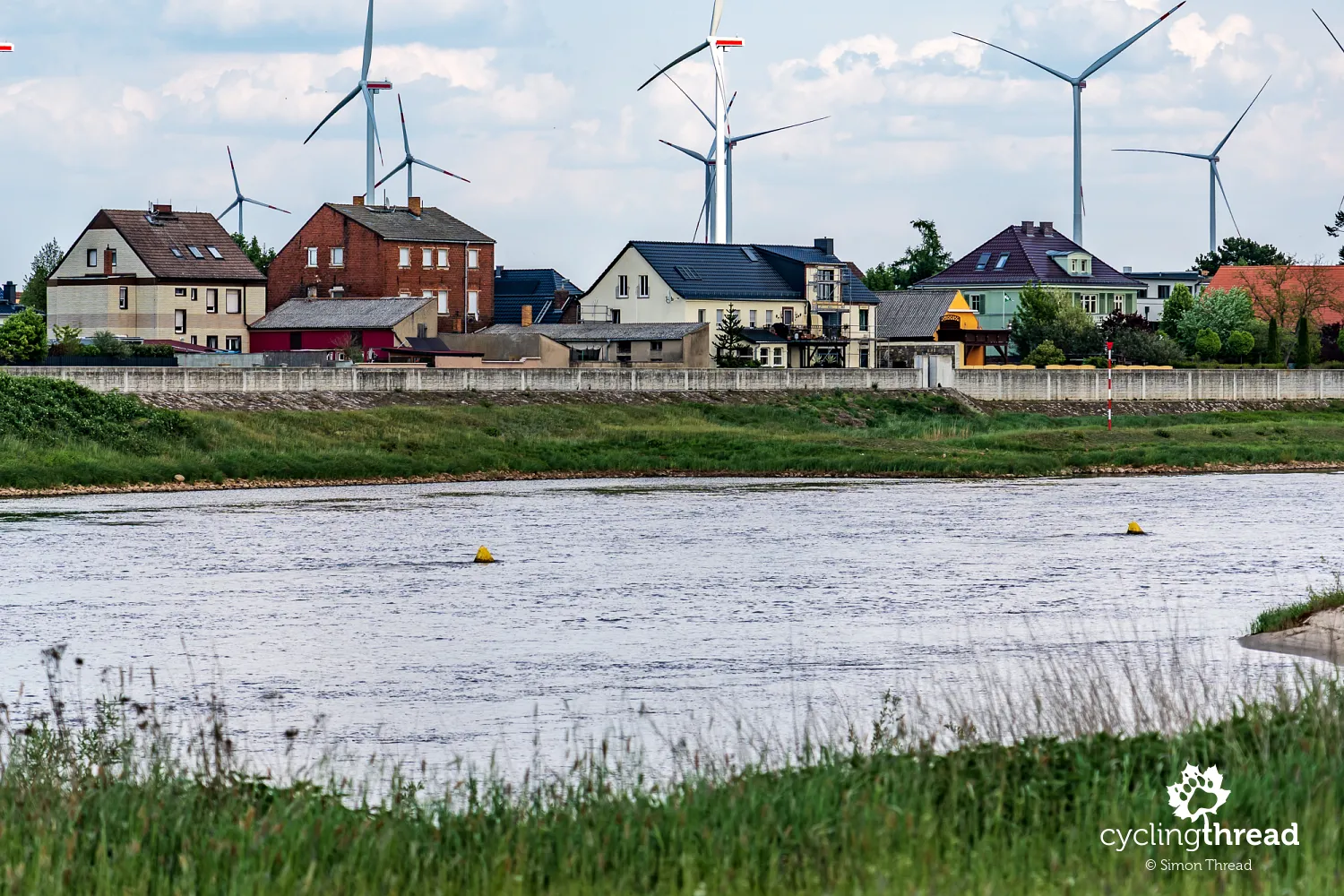
Wittenberg - second best after Dresden
Wittenberg, officially known as Lutherstadt, or "Luther City", turned out to be the second most interesting and enjoyable place of our whole trip - just behind Dresden. While Torgau had felt somewhat empty and sleepy, Wittenberg was the complete opposite - despite being just a day’s ride away! The lively Collegienstraße, the city’s main street, the crowds in museums and churches that are a must-see in Wittenberg, the buzzing cafés, the vibrant restaurants, even the completely full bike room in our hotel - all of it painted a picture of a city that is alive, welcoming, and tourist-friendly. Without hesitation, we add Wittenberg to the list of places we’ll gladly return to in our memories.
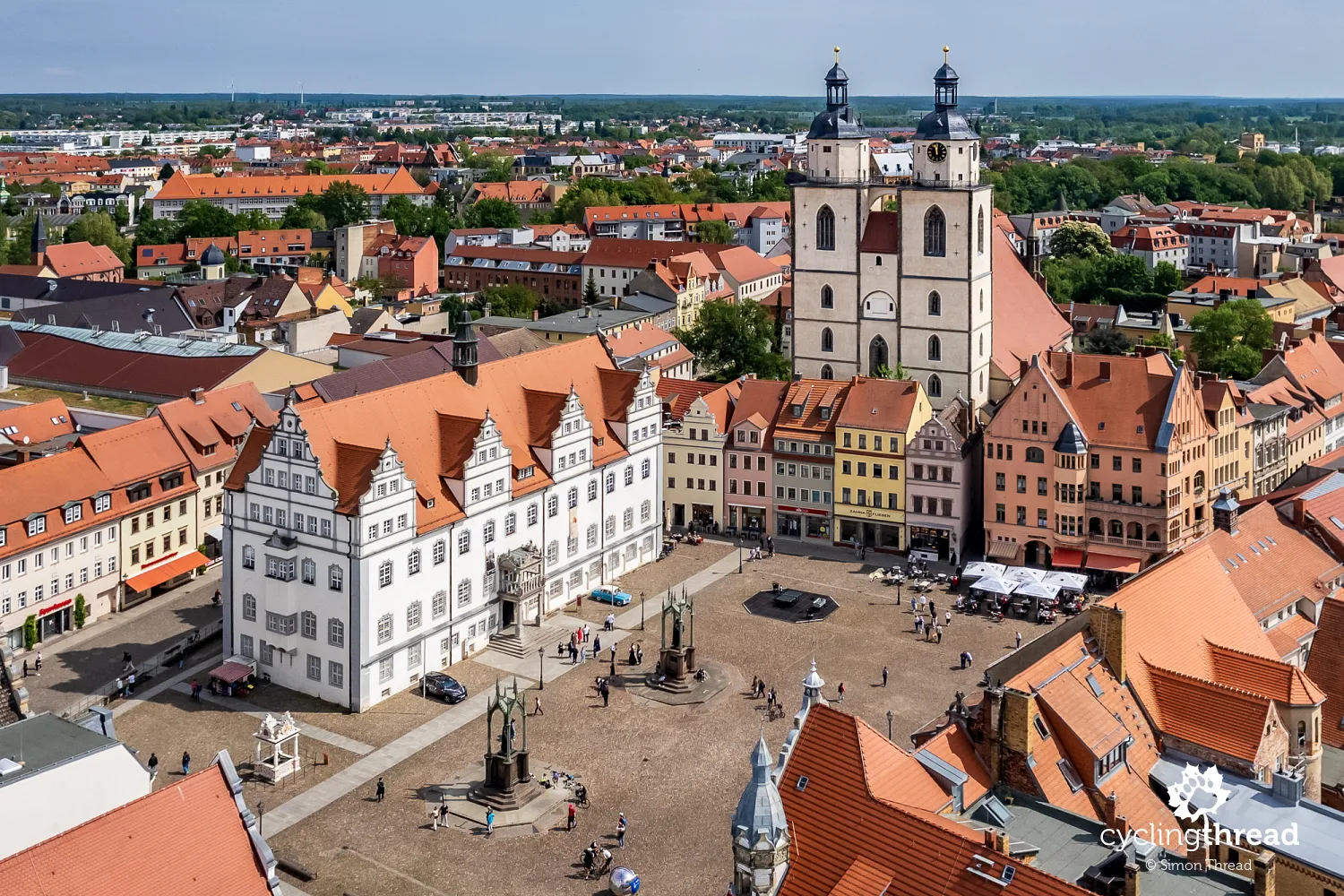
Exploring Wittenberg is impossible without encountering traces of Martin Luther - they give the city its unique identity. The two most important sites are the Castle Church, where Luther is said to have nailed his 95 theses to the door, and the Town Church of St. Mary, where he preached. Both are impressive, not just for their historical significance, but for their architecture as well - especially the interior of the Castle Church, with the graves of Luther and Melanchthon. Its high vaults, soft light, and minimalist design give the space a solemn quietness that invites reflection. Also worth noting are the many plaques, epitaphs, and Reformation-era details scattered throughout the church. Although the entrance is tucked away somewhat unintuitively in the inner courtyard - and there’s an admission fee - the place is definitely worth the effort.
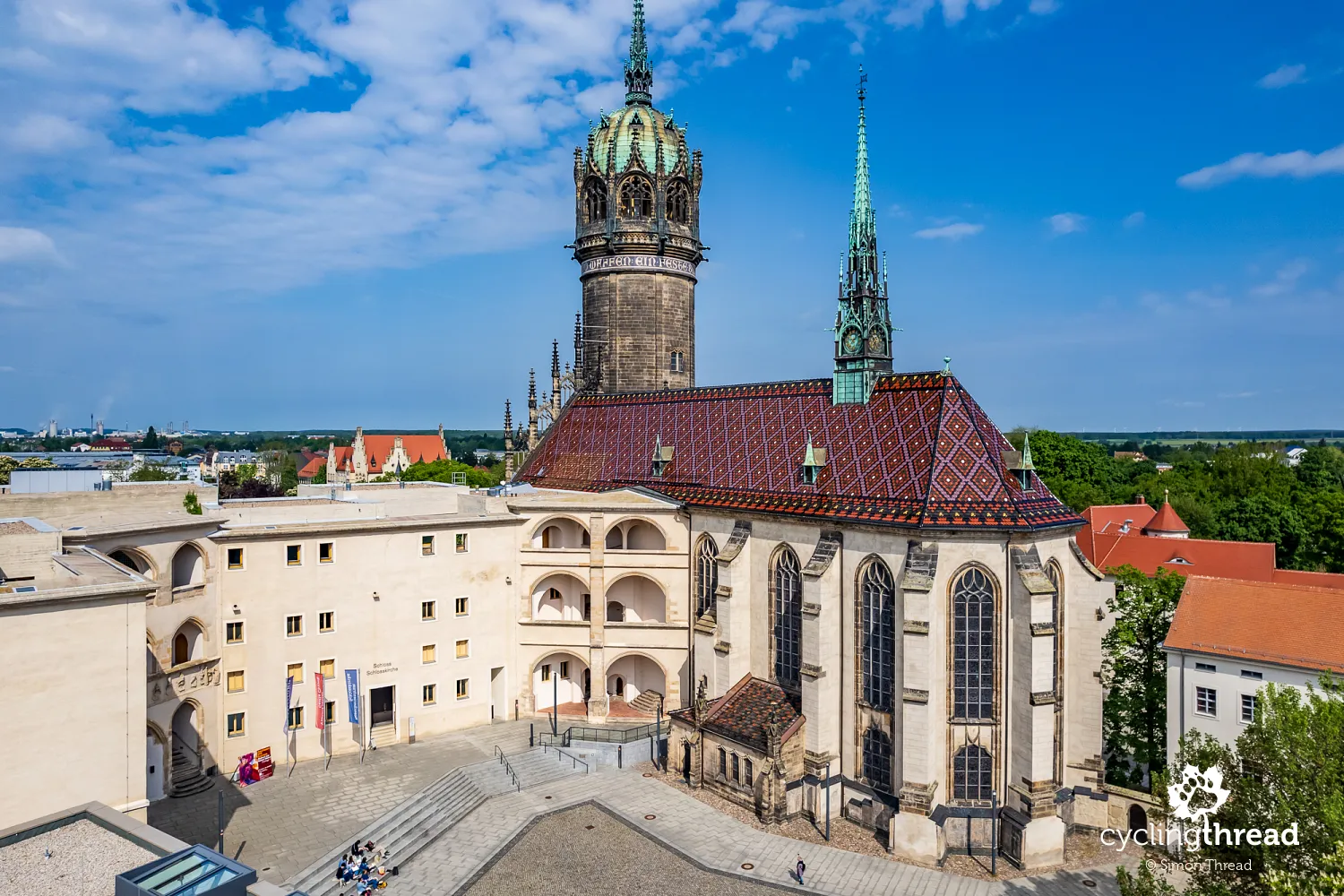
At the other end of the historic old town stands the Augusteum - a former Augustinian monastery now housing a museum devoted to Martin Luther. It’s here you can dive into the reformer’s life and better understand how deeply his work shaped the course of European history. At the moment, the main part of the museum, Luther’s actual home, is undergoing renovation. But a temporary - and very well-designed - exhibition has been set up next door in the Augusteum. The expanded display covers not only Luther’s personal life but also the wider historical context - featuring old printed works, portraits of his family, everyday objects, and liturgical items from his era. Together, they show Luther not just as a theologian, but as a husband, father, and citizen of his time.
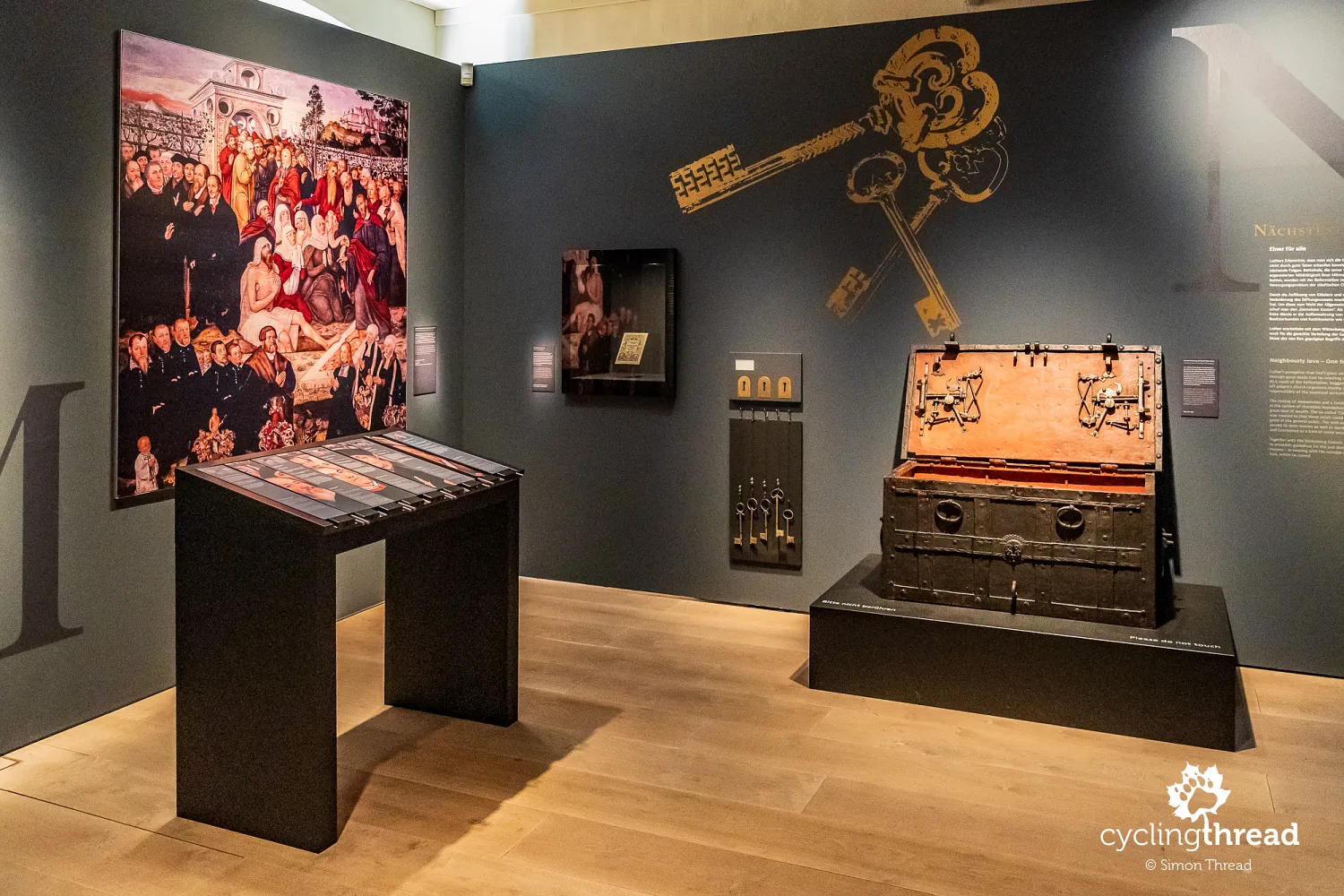
Cyclist‑friendly hotels along Elberadweg
We also have fond memories of our overnight stay in Lutherstadt Wittenberg. Hotel Cranach-Herberge, located right next to the main square, had a charming historic room adapted for bicycles. It was completely filled, of course - that night, many cycling tourists had chosen the same place to stay. And while we're on the topic, it's worth mentioning another bike-friendly gem: Sleep&Go Hotel in Magdeburg. Its spacious basement bike room truly impressed us – wall-mounted racks all around made it easy to secure the bikes overnight, and there was even a shelf with chargers for e-bikes.
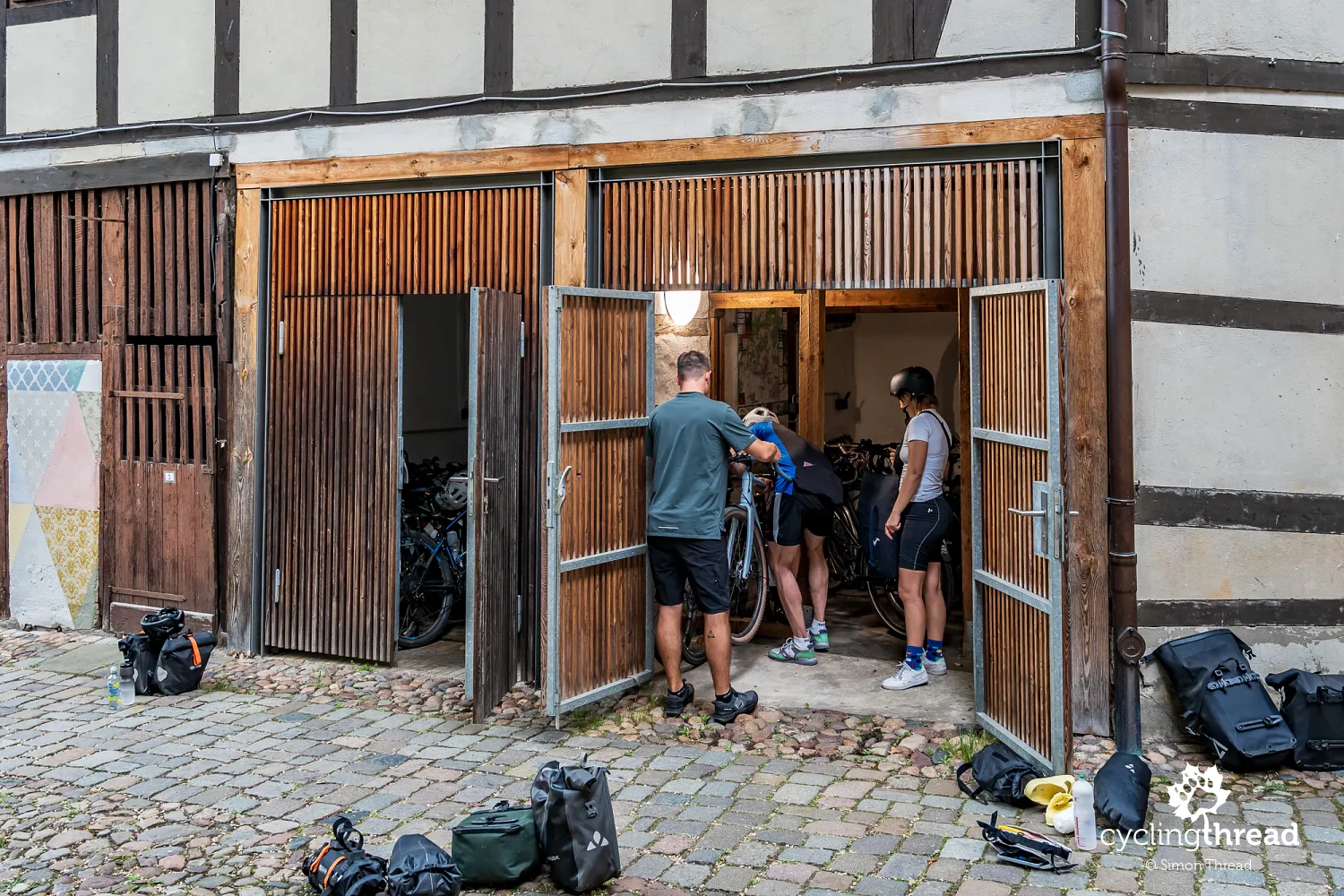
The absolutely enchanting Dessau-Wörlitz Gardens
A pleasant, nature-filled section of the route took us from Wittenberg to Dessau-Roßlau, with a stop in the beautiful town of Wörlitz. More precisely - in the Wörlitz Gardens, which are part of the expansive palace and park complex listed as a UNESCO World Heritage Site under the name Dessau-Wörlitz Gardens. It’s one of the first landscape parks in Europe inspired by Enlightenment ideals, created in the second half of the 18th century by Prince Leopold III of Anhalt-Dessau. The vast park delights with its picturesque layout of canals, bridges, pavilions, and temples, all thoughtfully integrated into the natural landscape with a keen sense of aesthetics. Although cycling through the gardens is not allowed, walking along their pathways is a pure pleasure. Wörlitz exudes calm and harmony - it's a perfect place for a break, a leisurely walk, or a picnic with a view of the neoclassical palace reflected in the water.
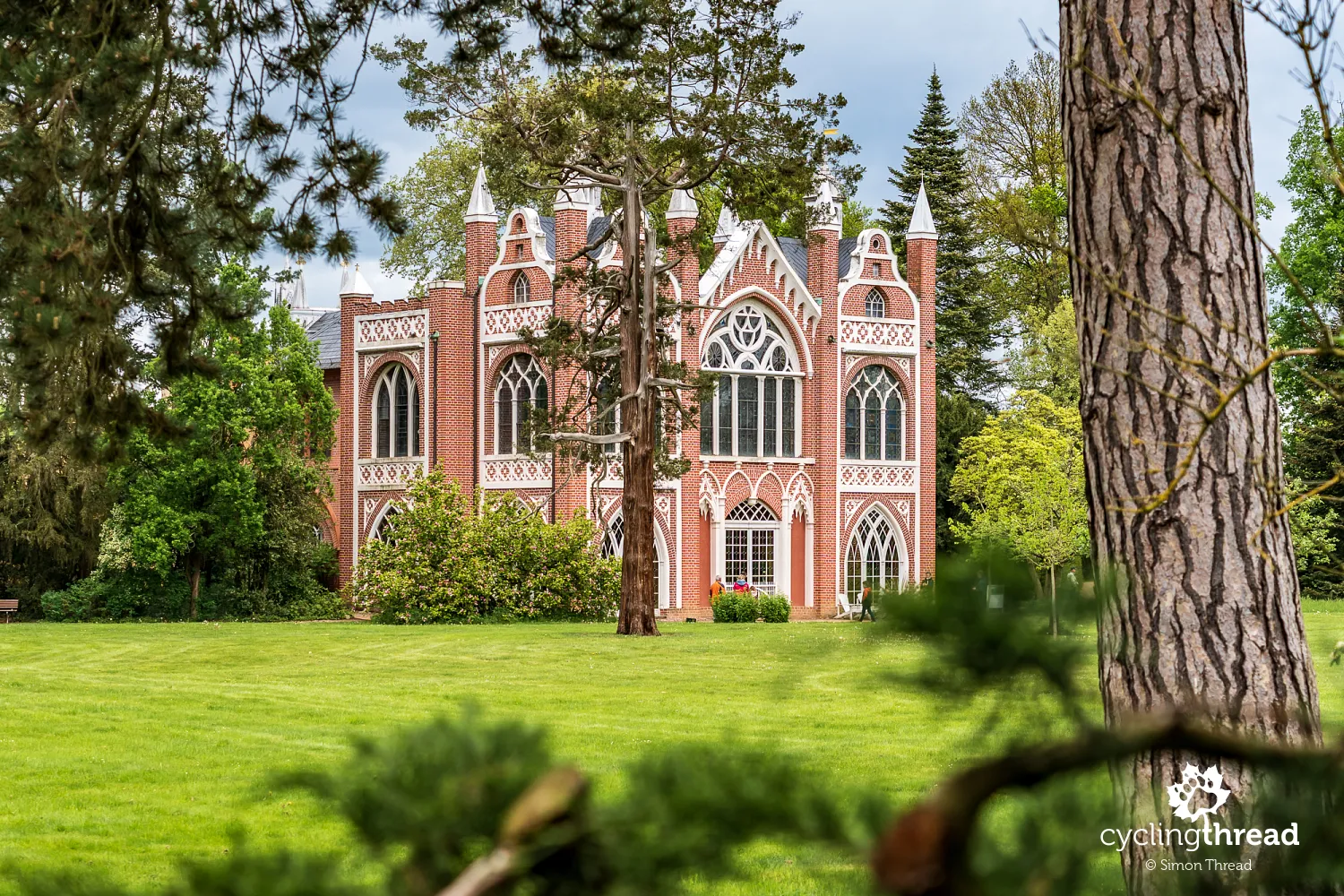
The entire Wörlitz complex spans around 112 hectares, and a full loop around it covers at least 5 kilometers - making it one of the largest and best-preserved English landscape gardens on the continent. Full of symbolism, hidden meanings and architectural surprises, it encourages slow exploration, step by step. We saw only a small part of the park, where we happened upon the Gothic House, which had been taken over by peacocks. A dozen or so of these beautiful birds had completely claimed the area, perching on rooftops, fountains, and garden walls while loudly announcing their presence. Their piercing calls echoed through the gardens, providing an unusual soundtrack to a walk among carefully designed greenery and romantic architecture.

The part of the Dessau-Wörlitz Gardens located within Dessau-Roßlau leaves a smaller impression. In fact, the level of protection here is less strict - cycling is allowed! The main attraction in this area is the mausoleum of the Anhalt princely family, a neoclassical building from the early 20th century, surrounded by a quiet forest park. The park lies between Dessau and the riverbank, making it a natural stretch of the Elbe cycling route. This section of the gardens has a wilder, more casual character - paths wind through loosely arranged meadows and groves, and it’s easy to find a shady spot for a break under the trees. While it doesn’t impress like Wörlitz, it offers a pleasant contrast - a less formal, more everyday encounter with nature.
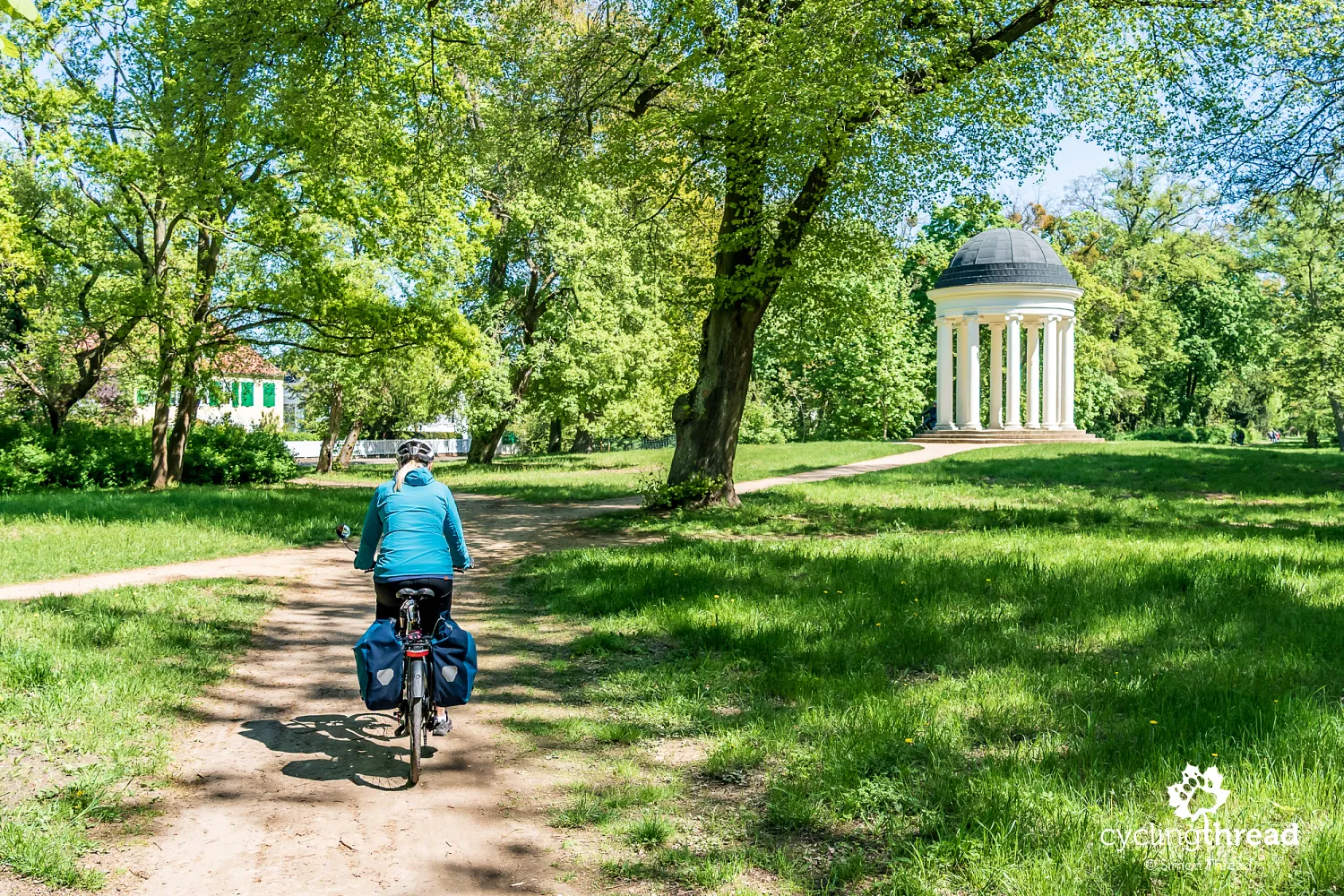
Bauhaus: revolutionary design in Dessau-Roßlau
Dessau-Roßlau is best known for something entirely different - the Bauhaus. This is the city that became the main stage for one of the most important revolutions in 20th-century architecture and design. In 1925, after relocating from Weimar, the Bauhaus school established its new headquarters here - designed by its director, Walter Gropius. The building’s modernist form, with glass curtain walls, steel structure, and functional layout, is still considered an icon of modern architecture. In the city center stands the contemporary Bauhaus Museum, opened in 2019, housing the world’s largest collection of designs, furniture, drawings, and everyday objects linked to the movement. It’s a must-see not only for design enthusiasts - the clear signage and visual storytelling make the museum approachable for anyone curious about the world of Bauhaus.
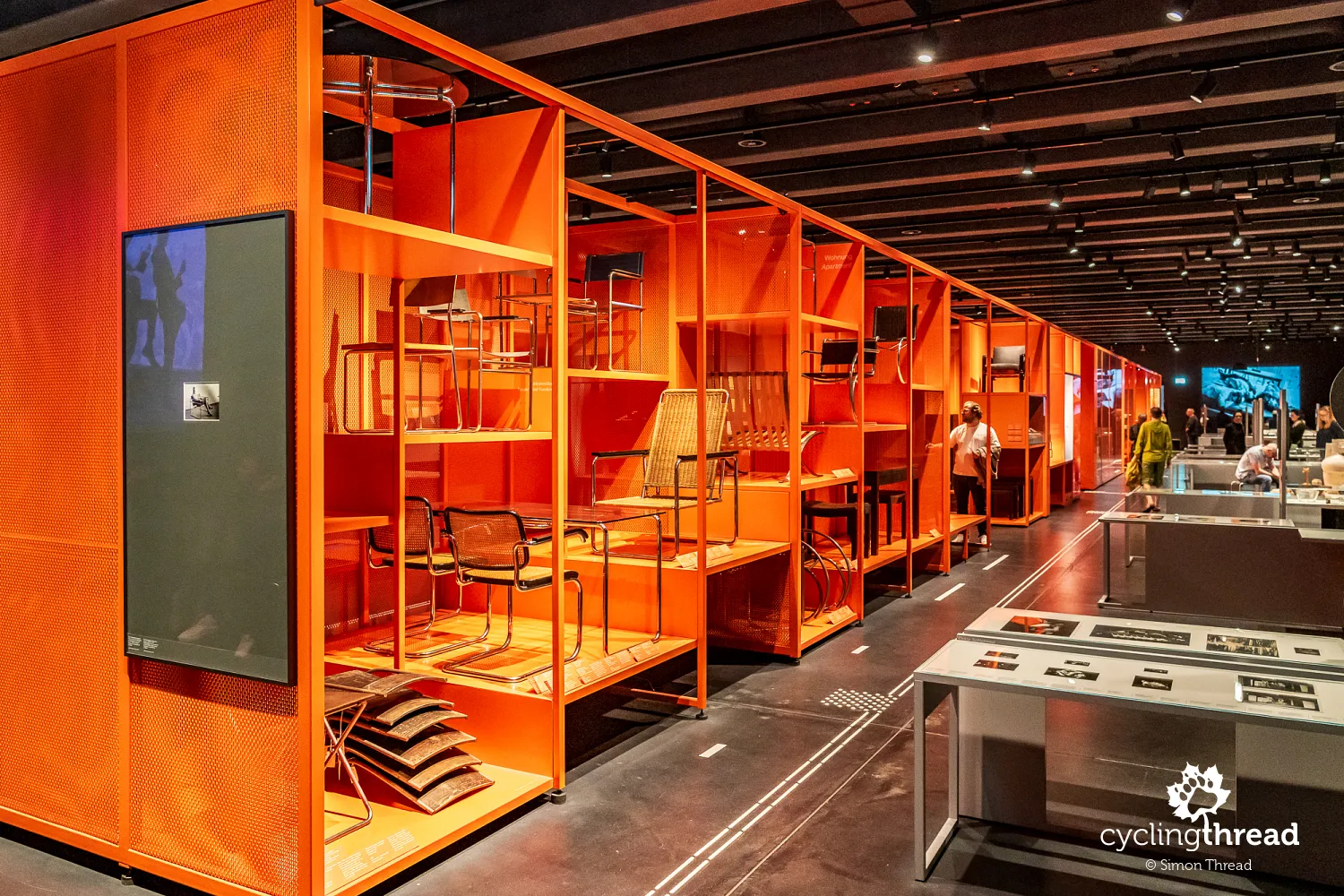
Another must-see site is the group of model houses (Meisterhäuser), also designed by Gropius as living and working spaces for Bauhaus masters like Kandinsky, Klee, and Feininger. The simple geometric forms, flat roofs, large windows, and minimalist style were groundbreaking at the time - and they still impress today with their clarity and architectural logic. It's also worth stepping inside the original Bauhaus school building - a true icon of modern architecture, where original features like the cafeteria, theater hall, and staircases with distinctive railings have been preserved. The entire ensemble leaves a powerful impression - not only as historical landmarks, but as a vision of a better world imagined in the interwar years, one that continues to inspire even today.
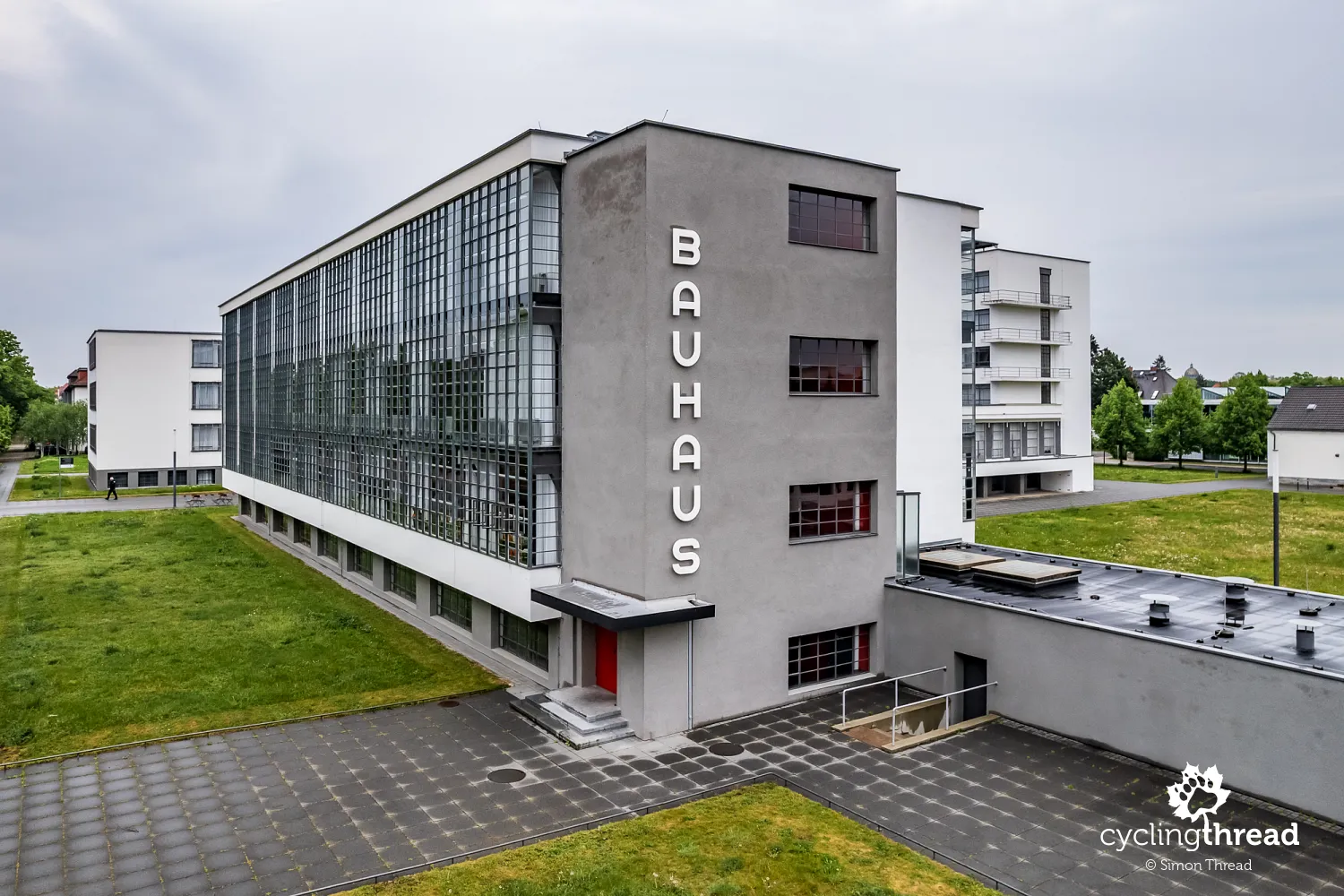
Three UNESCO World Heritage Sites in one day
In the span of just one day, we visited places linked to three different UNESCO World Heritage listings - the "Luther Memorials in Eisleben and Wittenberg", the "Dessau-Wörlitz Garden Realm" and "The Bauhaus and its Sites in Weimar, Dessau and Bernau". What’s more, each site told a completely different story, highlighting a distinct aspect of the region’s heritage. Lutheran Wittenberg immersed us in the world of spiritual transformation and religious revolution, the Dessau-Wörlitz Gardens reflected an Enlightenment vision of harmony between humans and nature, and Bauhaus in Dessau opened a fascinating chapter in the development of modern architecture and design. It's remarkable how such diverse threads - from religion to landscape to design - intersect in one region, along a single cycling route.
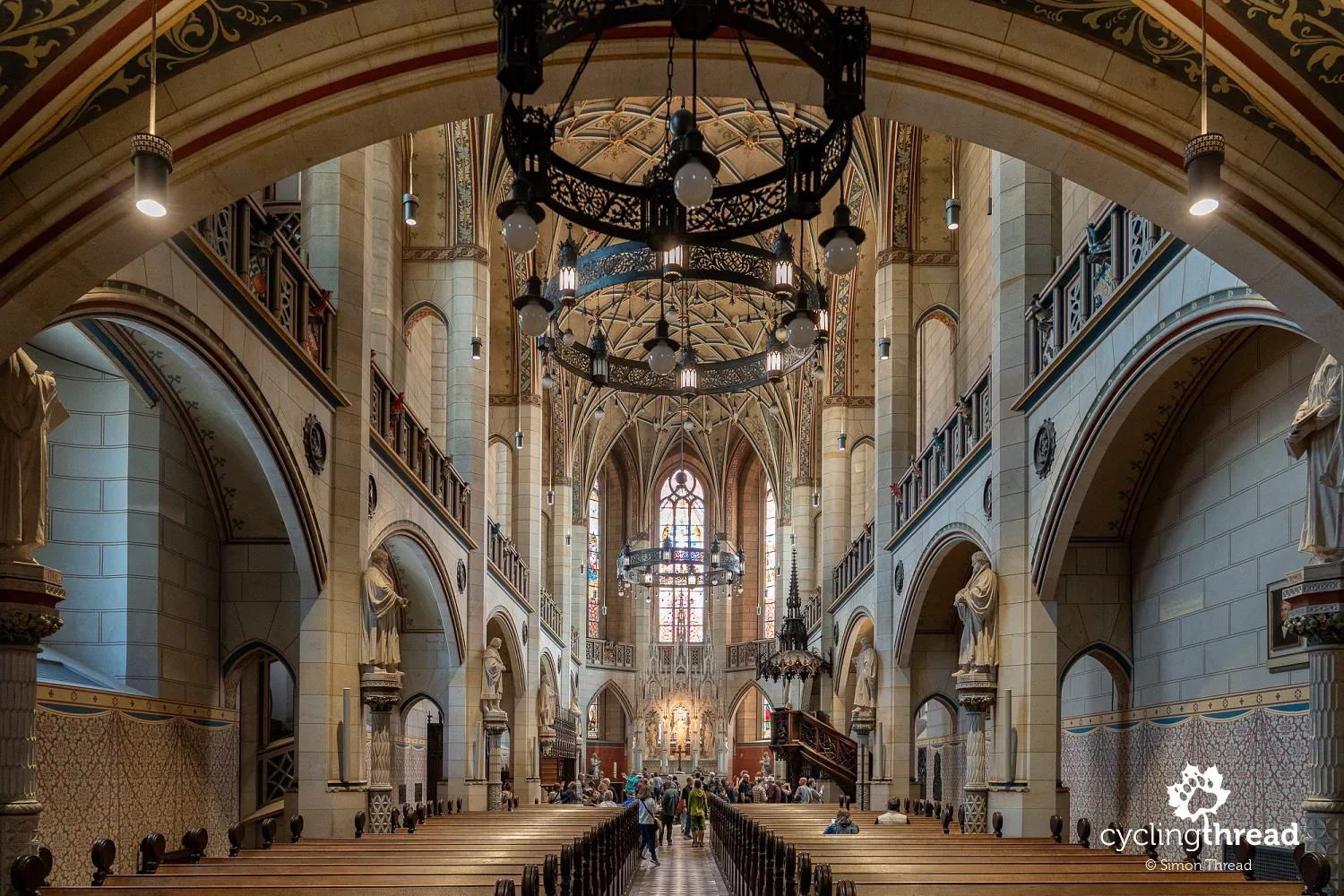
Dessau-Roßlau demolishes housing blocks
While preparing for the trip, we came across an intriguing fact: one of the most radical examples of "urban shrinkage" in eastern Germany is taking place in Dessau-Roßlau, a city crossed by the Elbe Cycle Route. Known for its Bauhaus avant-garde, the city has faced a significant population decline in recent decades - between 1990 and 2006 alone, Dessau lost 20 percent of its residents. Rather than ignoring the trend, local authorities took bold action - demolishing hundreds of vacant apartments and transforming the land into green spaces, designed in collaboration with the community. Cycling through this area, you can feel the change: wide alleys, newly planted squares, silence. These aren’t typical suburbs - they’re the landscape left behind after a demographic earthquake, and also a sincere attempt to adapt to the city’s new scale. Elberadweg doesn’t just lead through scenic valleys and historic towns - it also passes through places where you can clearly see how modern Europe is transforming.
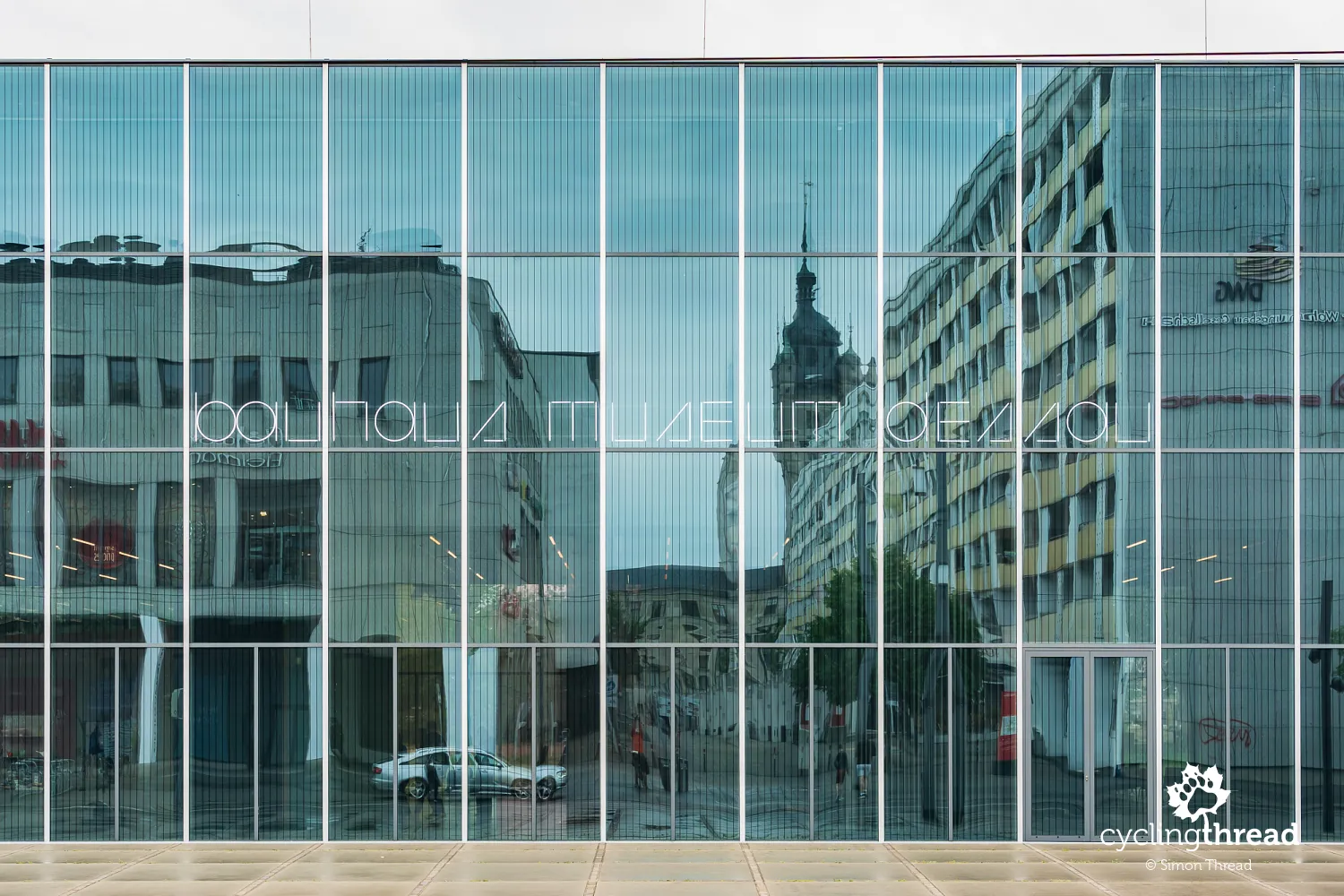
The red kite - a guardian of the Elbe
As we approached the final ferry of our route, we once again heard a familiar swoosh. A red kite soared overhead - a sight that has become almost routine in this part of Saxony. The Elbe region offers ideal conditions for this bird of prey: a mosaic landscape of meadows, fields, and tree clusters, easy prey, and minimal chemical use make this one of the red kite’s most important breeding grounds in Europe. It’s estimated that over a thousand breeding pairs live in Saxony alone, making the region one of the species’ strongholds in Germany. Encountering this bird not only adds a special moment to a day on the bike but also serves as a reminder that the Elbe Route is a fantastic corridor for nature observation - vivid, authentic, and surprisingly in tune with human life.
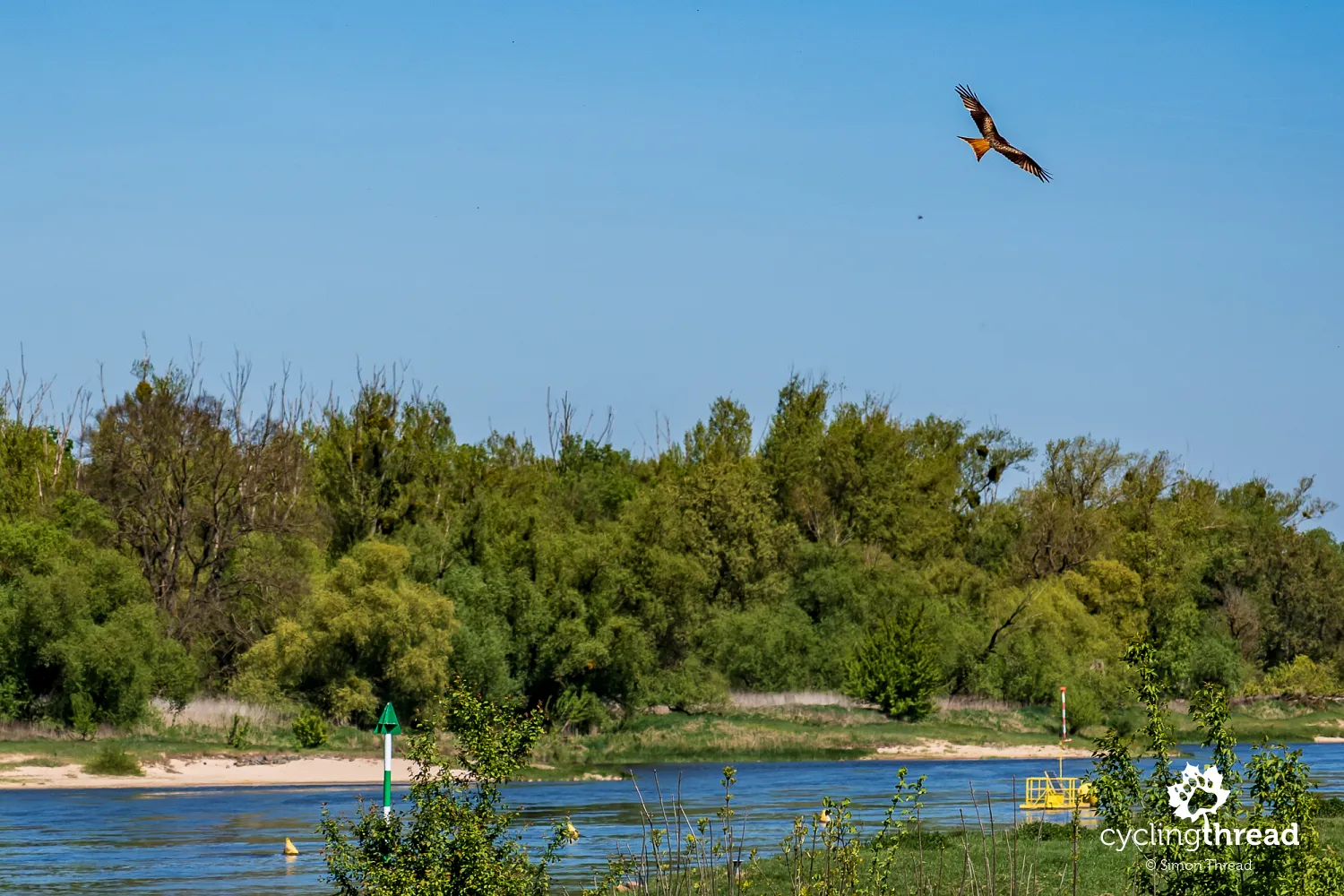
Concrete barriers protect the forest
A little later, in the woods, we came across another example of smart cycling infrastructure - a large concrete block placed across the forest road, right between the traffic lanes. Its purpose is to effectively block access for private cars while still allowing passage for larger forestry vehicles. Next to the barrier, cyclists can pass freely, and a side gate can be opened by forestry services if needed. Interestingly, a nearly identical solution is used in the cycling region of West Pomerania in Poland along the Western Lakelands Route.

Small castles and palaces along the route
In the small villages of Walternienburg and Dornburg, we visited two original landmarks. The first, in Walternienburg, is a modest fortress with roots reaching back to the 10th century - its stone tower and fragments of walls, once surrounded by a moat, have been preserved to this day. The site once belonged to the archbishops of Magdeburg and served as an important checkpoint for river crossings on the Elbe. In Dornburg, we stopped at a much larger palace from the mid-18th century - a classic baroque residence with a stately façade and landscaped park. It was built at the initiative of the von Hagen family and designed by Christian Gottfried Hübner, the court architect of the Principality of Anhalt-Zerbst. The original plan called for a three-winged palace, but only one wing was ever completed.
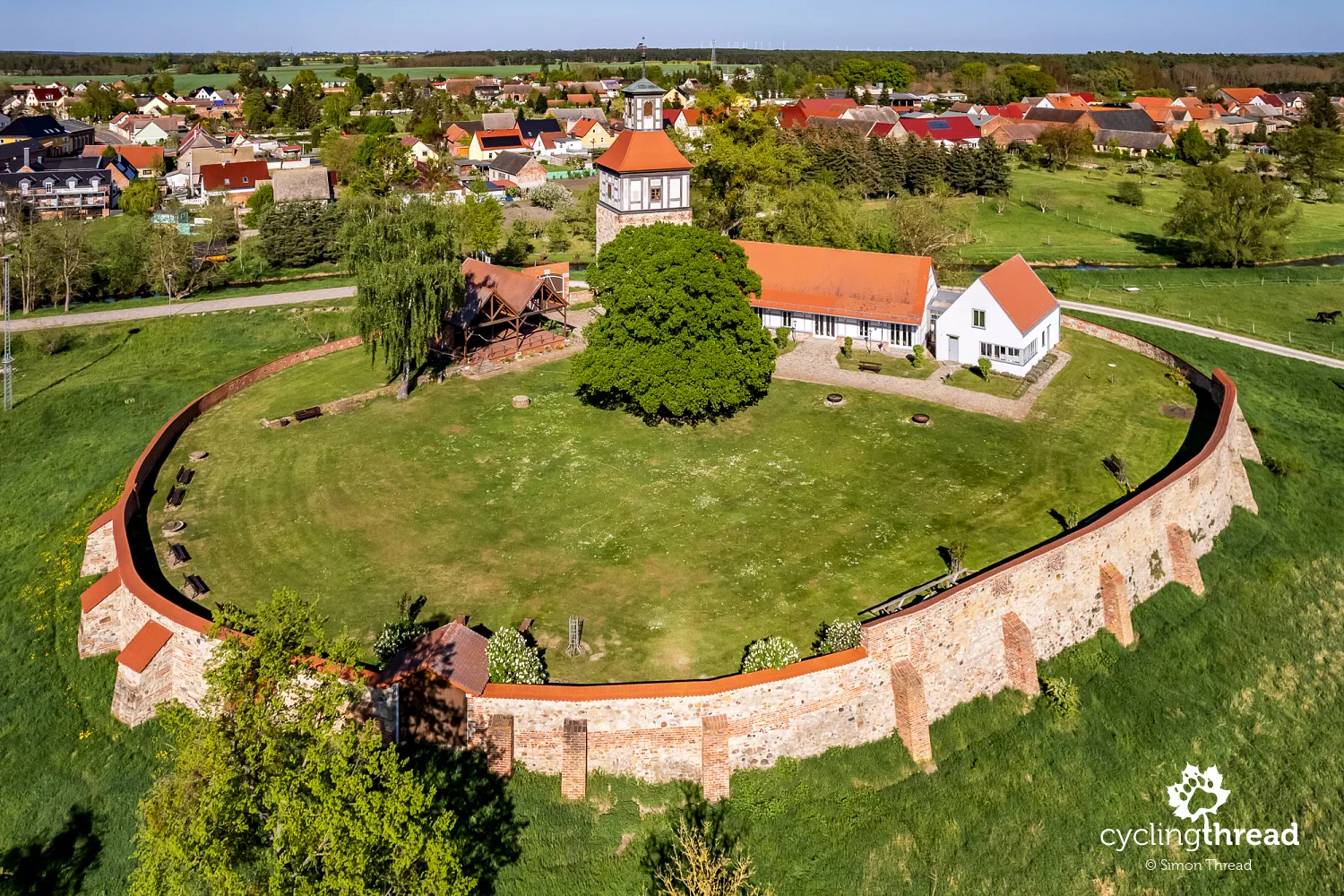
An extraordinary flood protection structure
The most remarkable flood protection site we encountered along the Elbe - the one we hinted at earlier - was the Pretziener Wehr near Pretzien, which we reached near the end of our last day on the route. This impressive weir, built in the late 19th century, sits by the Elbeumflut - a side arm of the river that serves as a relief channel during floods. Pretziener Wehr is the oldest surviving flood barrier of its kind in Germany, and at the time of its construction, it was the largest such structure in Europe, enabling controlled diversion of the Elbe’s main flow. It consists of nine spans with a total opening width of around 113 meters, each fitted with 36 steel panels weighing 100 kilograms apiece. During the August 2002 floods, the channel carried 1,050 m³/s - roughly 24% of the Elbe’s total discharge - reducing the water level in Magdeburg by about half a meter. The site is a powerful reminder that even in the 19th century, people understood the need to balance engineering with the landscape - without resorting to massive concrete walls. As of April 2024, the Pretzien weir has been added to Germany’s tentative list for UNESCO World Heritage status.

Magdeburg left us expecting more
Magdeburg… At first glance, it’s a bit underwhelming. But to appreciate it, you have to look more closely. The city was nearly wiped out during World War II - Allied bombings in 1945 reduced its historic center to ruins. It lacks the compact old town and medieval charm found in many other German cities. Yet one structure rises prominently above the modern, rather stark surroundings: the Cathedral of Saints Catherine and Maurice - the oldest Gothic cathedral in Germany and the burial place of Emperor Otto I. Construction began in 1209 on the site of an earlier Romanesque church, founded by Otto himself, who intended to make Magdeburg a center of power and faith. The building took nearly 300 years to complete and still impresses with its scale and detail - it's over 100 meters long, and its towers rise to 104 meters. Inside are valuable medieval artworks, including a Romanesque statue of Saint Maurice - one of the earliest realistic depictions of a Black person in European sculpture.
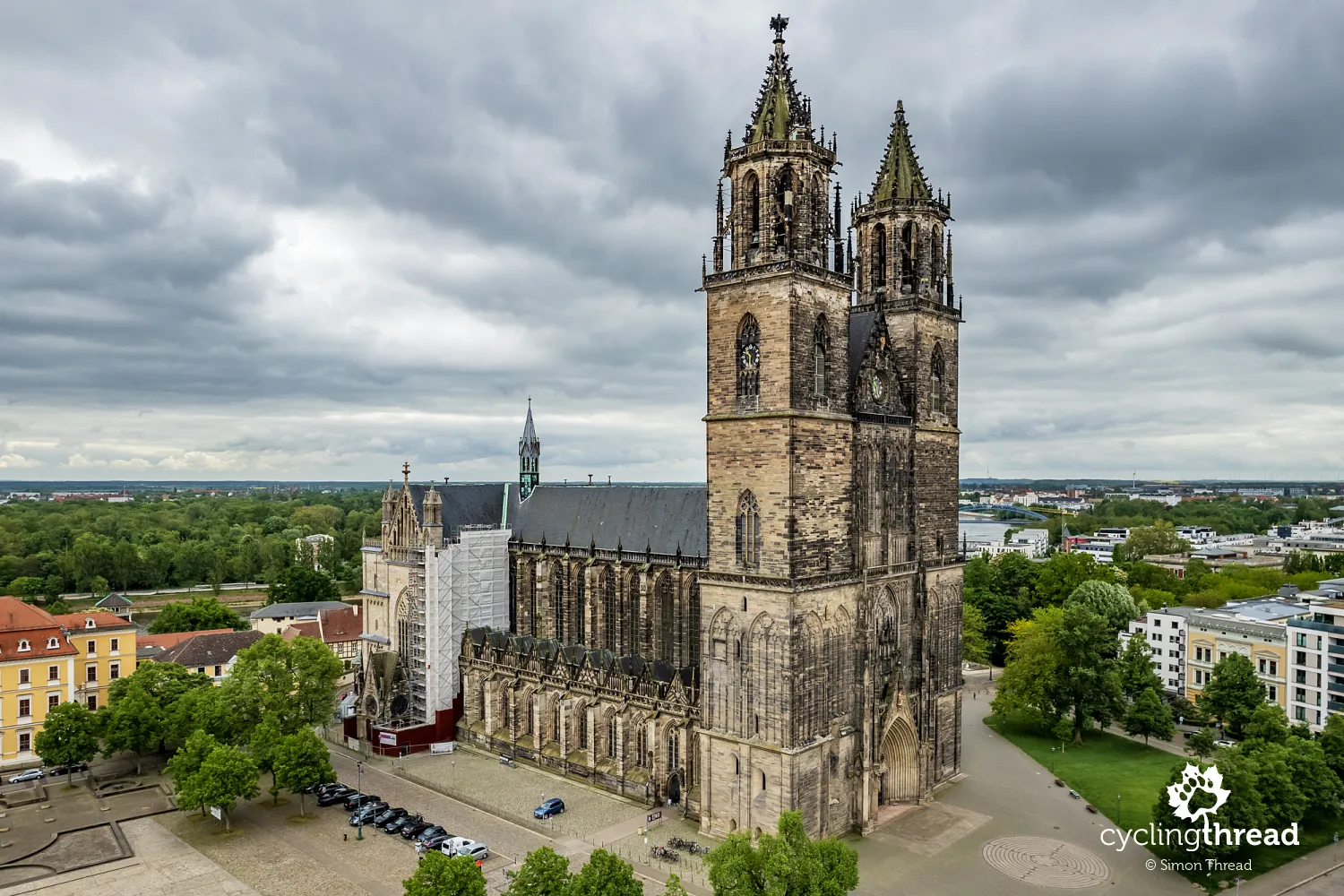
The Green Citadel, in stark contrast to the cathedral
A striking counterpoint to the Gothic cathedral is the Green Citadel in Magdeburg - a whimsical, pink complex designed by Friedensreich Hundertwasser. With its uneven façade, grassy rooftops, and golden domes, this building, completed in 2005, was the artist’s final work. It houses apartments, a hotel, shops, cafés, a kindergarten, and a theater, and its architecture rejects straight lines in favor of organic shapes and a closer connection to nature. The Green Citadel has become one of Magdeburg’s most iconic landmarks - a bold example of how art can reshape the fabric of a city. Engineering fans will be thrilled by the Kanalbrücke Magdeburg - Europe’s largest water bridge, where water flows… over a river.
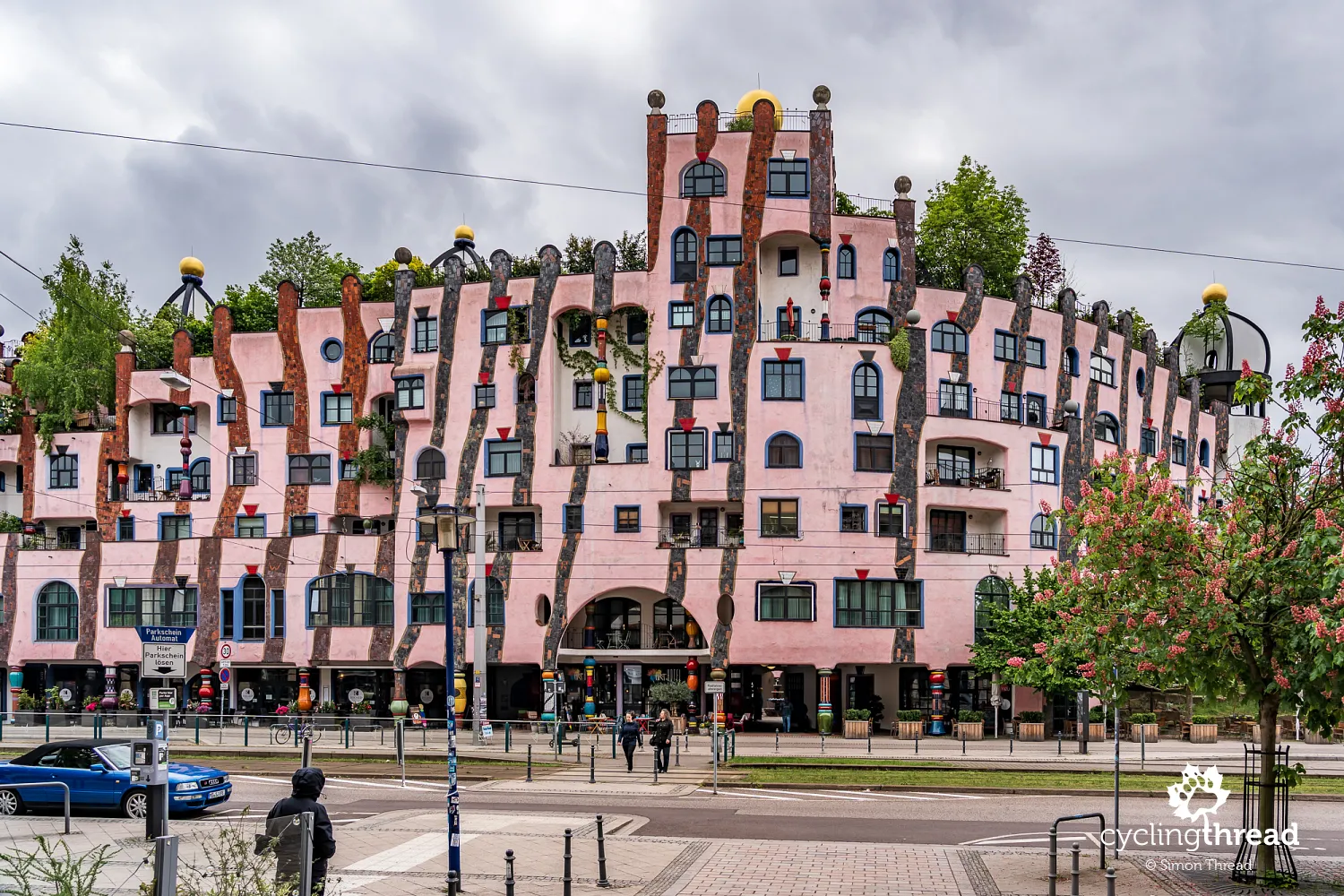
Exemplary German cycle wayfinding
Finally, one of my favorite topics - cycle signage. When writing about one of Germany’s most important cycling routes, I have to highlight the superb wayfinding system. Large, clear lettering on a light background makes it easy for cyclists to read signs without stopping. Add to that the helpful icons marking train stations, cyclist-friendly services, local sights, and essential amenities, as well as distinctive route symbols that aid with orientation and memory. At the top of each signpost is the general route direction - usually pointing to a larger town - while the lower section shows the next immediate destination or point of interest. It’s all logical, consistent and easy to follow. Here’s hoping all signs will always be this clear and cyclist-friendly.
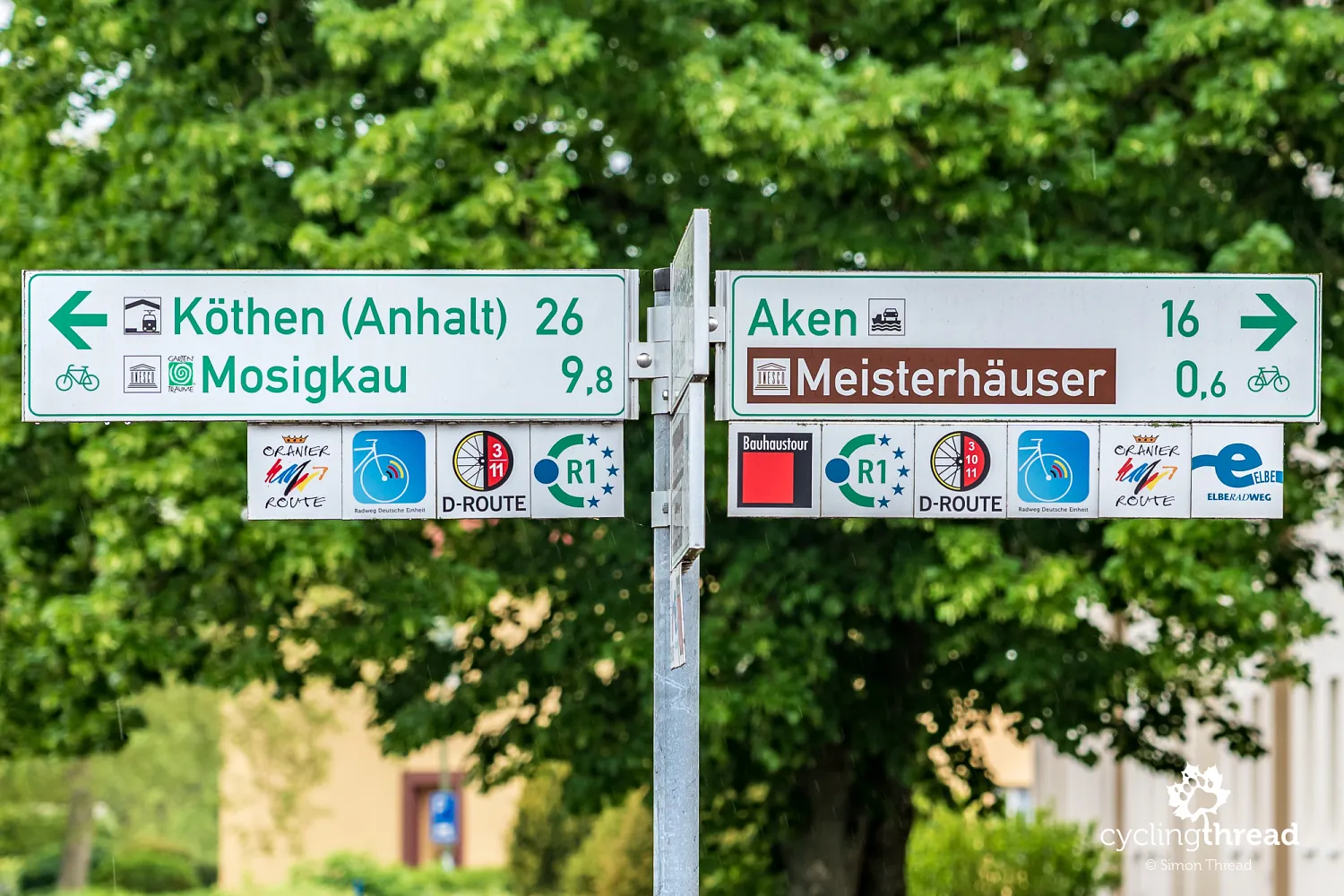
The Elbe Cycle Route leaves you richer
The Elbe Cycle Route - Elberadweg - is without question one of those must-ride routes. It's a European classic, drawing thousands of cyclists from across the continent every year. And yet it's a classic with many faces - changing not only with the direction of travel, but even depending on which side of the river you ride. Along the Elbe, even a simple out-and-back ride on the same section can feel entirely new - with a different shade of water, a shift in the light, or a fresh perspective on familiar towns. It's a route that never gets old - the rhythm of the river, the changing weather and the passing seasons make every journey feel unique.

But more than that, the Elbe Cycle Route is one of those rare routes that leaves you richer - with experiences, impressions and unexpected encounters. Winding through peaceful landscapes and historic cities, it invites you to slow down and immerse yourself in the region's atmosphere. Well-designed and clearly signposted, it gives space for reflection, conversation and the simple joy of the ride. This is how cycling tourism should feel - unhurried, close to nature and full of quiet connection. And long after the journey ends, the memories, the photos and the lightness in your legs remind you that it was all worth it.
Back to topHave a safe ride! 💚
Simon Thread
(Szymon Nitka)
I'm a passionate cycling traveler and the voice behind Cycling Thread. I explore Europe on two wheels, documenting the most scenic routes, inspiring places, and cyclist-friendly practices. My writing blends personal experience with practical insights and a deep love of travel. I'm also a contributor to National Geographic Traveler magazine.



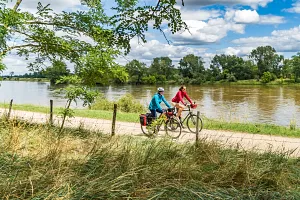
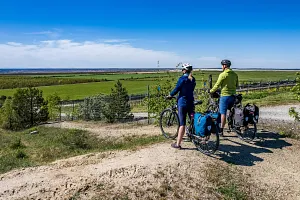
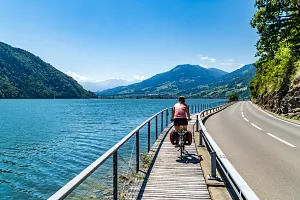
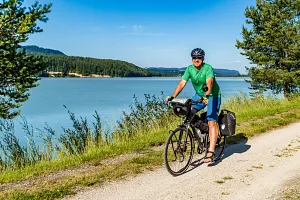
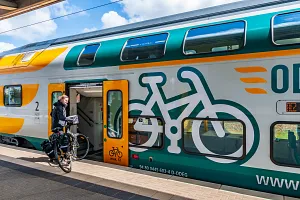
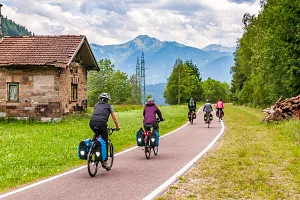
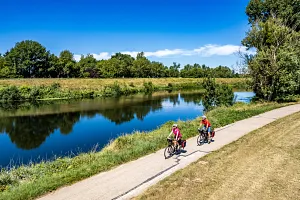
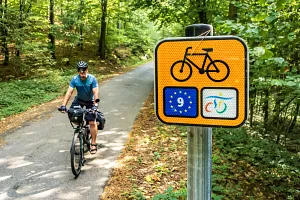

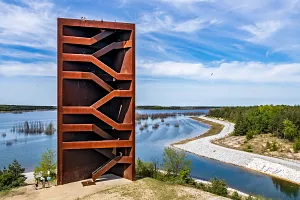

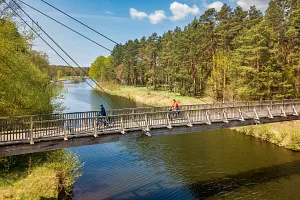

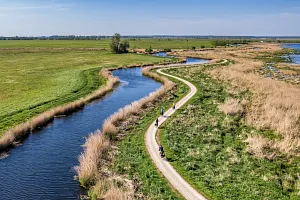
Your Comments
Add new comment